
Project Gutenberg's The Sandman: His Farm Stories, by William J. Hopkins This eBook is for the use of anyone anywhere at no cost and with almost no restrictions whatsoever. You may copy it, give it away or re-use it under the terms of the Project Gutenberg License included with this eBook or online at www.gutenberg.org Title: The Sandman: His Farm Stories Author: William J. Hopkins Illustrator: Ada Clendenin Williamson Release Date: May 22, 2011 [EBook #36185] Language: English Character set encoding: ISO-8859-1 *** START OF THIS PROJECT GUTENBERG EBOOK THE SANDMAN: HIS FARM STORIES *** Produced by Eric Skeet, Beginners Projects and the Online Distributed Proofreading Team at https://www.pgdp.net (This file was produced from images generously made available by The Internet Archive/American Libraries.)
The Sandman: His Farm Stories
The Sandman: More Farm Stories
The Sandman: His Ship Stories
The Sandman: His Sea Stories
The Sandman: His Animal Stories
The Sandman: His Kittycat Stories
The Sandman: His Bunny Stories
The Sandman: His Puppy Stories
The Sandman: His Songs and Rhymes
The Sandman: His Indian Stories
The Sandman: His Fairy Stories
The Sandman: His Japanese Stories
L. C. PAGE & COMPANY
53 Beacon Street Boston, Mass.


Copyright, 1902
By The Page Company
All rights reserved
Made in U.S.A.
PRINTED BY THE COLONIAL PRESS INC.
CLINTON, MASS., U.S.A.
To
that
Little John
of to-day
who has inspired these stories
of that other
Little John
of long ago
this volume is
most affectionately
dedicated
Whatever may be thought of these stories by older people, they have served, with some others, to induce a certain little boy to go to sleep, and for nearly three years my one listener has heard them repeated many times, and his interest has never flagged. As the farm stories slowly grew in number, they entirely displaced the other stories, and that farm has become as real in the mind of my audience as it was in fact when little John was driving the cows, or planting the corn, seventy-five years ago.
The detail, which may seem excessive to an older critic, was in every case, until I had learned to put it in at the start, the result of a searching cross-examination. If the bars were not put up again, the cows might get out; and if the oxen did not pass, on their return, all the familiar objects, how did they get back to the barn? It is the young critics that I hope to please, those whose years count no more than six. If they like these farm stories half as well as my own young critic likes them, I shall be satisfied.
William J. Hopkins.
| CHAPTER | PAGE | |
| I. | The Oxen Story | 13 |
| II. | The Fine-Hominy Story | 21 |
| III. | The Apple Story | 36 |
| IV. | The Whole Wheat Story | 47 |
| V. | The Stump Story | 59 |
| VI. | The Horsie Story | 64 |
| VII. | The Log Story | 71 |
| VIII. | The Uncle Sam Story | 80 |
| IX. | The Market Story | 84 |
| X. | The Maple-Sugar Story | 96 |
| XI. | The Rail Fence Story | 110 |
| XII. | The Cow Story | 120 |
| XIII. | The Hay Story | 135 |
| XIV. | The Fireplace Story | 146 |
| XV. | The Baking Story | 156 |
| XVI. | The Swimming Story | 165 |
| XVII. | The Chicken Story | 175 |
| XVIII. | The Shawl Story | 184 |
| XIX. | The Buying-Farm Story | 198 |
| XX. | The Butter Story | 203 |
| XXI. | The Bean-Pole Story | 210 |
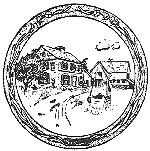 NCE upon a time there
was a farm-house, and
it was painted white
and had green blinds,
and it stood not far
from the road. And
in the fence was a wide gate to let the
wagons through to the barn. And the
wagons, going through, had made a track
that led up past the kitchen door and
past the shed and past the barn and past
the orchard to the wheat-field.
NCE upon a time there
was a farm-house, and
it was painted white
and had green blinds,
and it stood not far
from the road. And
in the fence was a wide gate to let the
wagons through to the barn. And the
wagons, going through, had made a track
that led up past the kitchen door and
past the shed and past the barn and past
the orchard to the wheat-field.
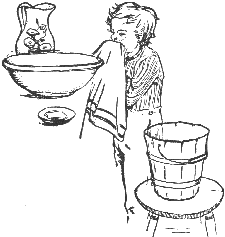
Not far from the kitchen door was a well, with a bucket tied by a rope to the end of a great long pole. And when they wanted water, they let the bucket down into the well and pulled it up full of water. They used this water to drink, and to wash their faces and hands, and to wash the dishes: but it wasn't good to wash clothes, because it wouldn't make good soap-suds. To get water to wash the clothes, they had a great enormous hogshead at the corner of the house.
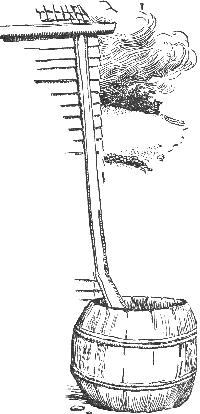
And when it rained, the rain fell on the roof, and ran down the roof to the gutter, and ran down the gutter to the spout, and ran down the spout to the hogshead. And when they wanted water to wash the clothes, they took some of the water out of the hogshead. But when it had not rained for a long time, there was no water in the hogshead. Then they got out the drag and put a barrel on it, and the old oxen came out from the barn, and put their heads down low; and Uncle John put the yoke over their necks, and put the bows under and fastened them, and hooked the chain of the drag to the yoke. There wasn't any harness, and there weren't any reins.
Then he said "Gee up there, Buck; gee up there, Star." And the old oxen started walking slowly along, dragging the drag, with the barrel on it, along the ground. And Uncle John walked along beside them, carrying a long whip or a long stick with a sharp end; and little John walked along by the drag.
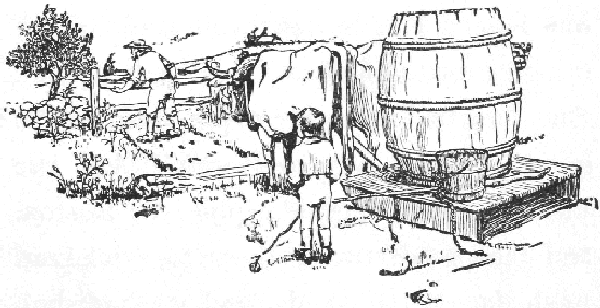
And they walked slowly out of the yard into the road and along the road until they came to a big field with a stone wall around it, and a big gate in the stone wall. It wasn't a regular gate, but at each side of the open place in the wall there was a post with holes in it. And long bars went across and rested in the holes. And the old oxen stopped, and Uncle John took the bars down and laid them on the ground. Then the oxen started and walked through the gate and across the field until they came to the river. And when they came to the river, they stopped. The little river and the field are not there now, because the people put a great enormous heap of dirt across, and the river couldn't get through. The water ran in and couldn't get out, and spread out all over the field and made a big pond. And they had some great pipes under the ground, all the way to Boston. And the water runs through the pipes to Boston, and the people use it there to drink, and wash faces and hands, and wash dishes, and wash clothes.
Well, when the old oxen stopped at the river, Uncle John took his bucket and dipped it in the river, and poured the water into the barrel until the barrel was full. Then he said "Gee up there," and the old oxen started slowly walking across the field. And the drag tilted around on the rough ground, and the water splashed about in the barrel, and slopped over the top of the barrel on to the drag, and on to the ground. And the oxen walked out of the gate into the road and stopped. And Uncle John put the bars back into the holes, and the old oxen started again and walked slowly along the road, until they came to the farm-house, and in at the big gate, and up to the kitchen door, and there they stopped. And Uncle John unhooked the chain from the yoke, and took out the bows, and took off the yoke, and the old oxen walked into the barn and went to sleep. And they left the drag with the barrel of water by the kitchen door.
And the next morning, when they wanted water to wash the clothes, there was the barrel of water, all ready.
And that's all.
 NCE upon a time there
was a farm-house, and it was painted white
and had green blinds, and it stood not far
from the road. And
in the fence was a wide gate to let the
wagons through to the barn. And the
wagons, going through, had made a track
that led up past the kitchen door and
past the shed and past the barn and past
the orchard to the wheat-field.
NCE upon a time there
was a farm-house, and it was painted white
and had green blinds, and it stood not far
from the road. And
in the fence was a wide gate to let the
wagons through to the barn. And the
wagons, going through, had made a track
that led up past the kitchen door and
past the shed and past the barn and past
the orchard to the wheat-field.
Not far from the house there was a field where corn grew; and when the winter was over and the snow was gone and it was beginning to get warm, Uncle John got the old oxen out of the barn. And the oxen put their heads down, and Uncle John put the yoke over and the bows under, and he put the plough on the drag and hooked the drag chain to the yoke. Then he said: "Gee up there, Buck; gee up there, Star."
So the old oxen started walking slowly along the wagon track and out of the gate into the road. Uncle Solomon and Uncle John walked along beside them, and little John walked behind; and they walked along until they came to the corn-field. Then the oxen stopped and Uncle John took the bars down out of the holes in the posts, and the oxen geed up again through the gate into the corn-field.
Then Uncle John unhooked the chain from the drag and hooked it to the plough and said "Gee up" again, and the oxen started walking along across the field, dragging the plough. Uncle Solomon held the handles, and the plough dug into the ground and turned up the dirt into a great heap on one side and left a deep furrow—a kind of a long hollow—all across the field where it had gone. And the old oxen walked across the field, around and around, making the furrow and turning up the dirt, until they had been all over the field.
Then Uncle John unhooked the chain from the plough and hooked it on to the harrow. The harrow is a big kind of a frame that has diggers like little ploughs sticking down all over the under side of it. And the oxen dragged the harrow over the field and the little teeth broke up the lumps of dirt and smoothed it over and made it soft, so that the seeds could grow.
Then Uncle John unhooked the chain from the harrow and hooked it to the drag and put the plough on the drag and said "Gee up," and the oxen walked along through the gateway and along the road until they came to the farm-house. And they went in at the wide gate and up the wagon track until they came to the shed, and there they stopped. Then Uncle John unhooked the chain and took off the yoke, and the old oxen went into the barn and went to sleep; and Uncle John put the drag in the shed.
The next day Uncle John took a great bag full of corn, and put it over his shoulder and started walking along to the corn-field; and little John walked behind. And when they got to the corn-field, Uncle John put the great bag of corn on the ground and put some in a little bag and gave it to little John. Then Uncle John began walking across the field and little John walked behind. And at every step Uncle John stopped and made five little holes in the ground; and then he took another step and made five other little holes. And little John came after and he put one grain of corn in each hole and brushed the dirt over. And they went all over the field, putting the corn in the ground, and when it was all covered over, they went away and left it.
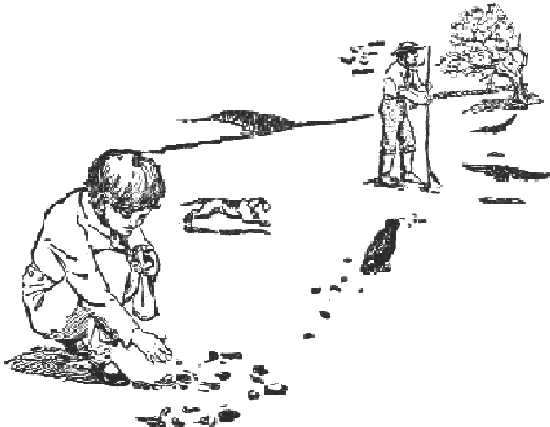
Then the rain came and fell on the field and sank into the ground, and the sun shone and warmed it, and the corn began to grow. And soon the little green blades pushed through the ground like grass, and got bigger and bigger and taller and taller until when the summer was almost over they were great corn-stalks as high as Uncle John's head; and on each stalk were the ears of corn, wrapped up tight in green leaves, and at the top was the tassel that waved about.

Then, when the tassel got yellow and brown and the leaves began to dry up, Uncle John knew it was time to gather the corn, for it was ripe. Then Uncle Solomon and Uncle John came out with great heavy, sharp knives and cut down all the corn-stalks and pulled the ears of corn off the stalks. And little John came and helped pull off the leaves from around the ears. Then the old oxen came out of the barn and Uncle John put the yoke over their necks and the bows up under and hooked the tongue of the ox-cart to the yoke. And he said "Gee up there," and the old oxen began walking slowly along, dragging the cart; and they went out the wide gate and along the road to the corn-field.
Then Uncle John and Uncle Solomon tossed the ears of corn into the cart; and when it was full, the old oxen started again, walking slowly along, back to the farm-house, in through the wide gate and up the wagon track and in at the wide door of the barn. And Uncle John put all the ears of corn into a kind of pen in the barn and the old oxen dragged the cart back to the corn-field to get it filled again; and so they did until all the ears of corn were in the pen.
And then Uncle John unhooked the tongue of the cart and put the cart in the shed, and he took off the yoke, and the oxen went into the barn and went to sleep.
The next morning Uncle Solomon and Uncle John and little John all went out to the barn and sat on little stools—low stools with three legs, that they sit on when they milk the cows—and rubbed the kernels of corn off the cobs. Then Uncle John put all the corn into bags and put it away; and he put the cobs in the shed, to use in making fires.
Then, one morning, Uncle John got out the oxen, and they put their heads down, and he put the yoke over their necks and the bows up under, and he hooked the tongue of the ox-cart to the yoke; and he said "Gee up there," and they walked into the barn. Then Uncle John put all the bags of corn into the cart, and he put little John up on the cart, and the old oxen started again and walked slowly along, down the wagon track, out the wide gate, and into the road.
Then they turned along the road, not the way to the field where they got the water, but the other way. And they walked a long way until they came to a place where there was a building beside a little river. And on the outside of the building was a great enormous wheel, so big that it reached down and dipped into the water.
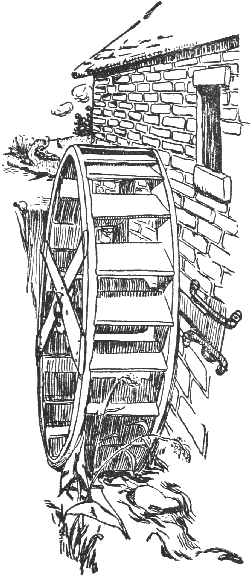
And when the water in the little river flowed along, it made the great wheel turn around; and this made a great heavy stone inside the building turn around on top of another stone. Now the building is called a Mill, and the big wheel outside is called a Mill-Wheel, and the stones are called Mill-Stones; and the man that takes care of the mill is called the Miller.
Now the miller was sitting in the doorway of the mill; and when he saw Uncle John and little John and the ox-cart filled with bags, he got up and came out, and called to Uncle John: "Good morning. What can I do for you this morning?" And Uncle John said: "I've got some corn to grind."
So the oxen stopped, and little John got down, and the miller and Uncle John took all the bags of corn into the mill, and the oxen lay down and went to sleep.
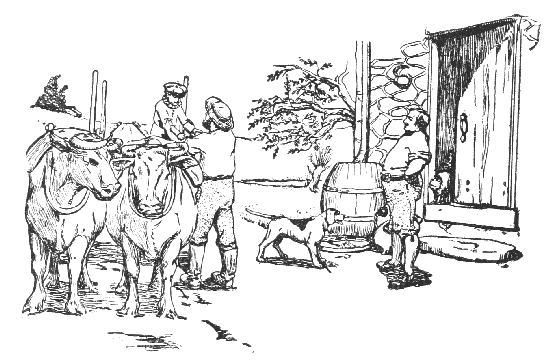
Then Uncle John and little John sat down on some logs in the mill, and the miller asked Uncle John how he wanted the corn ground. So Uncle John said he wanted some of it just cracked, and some of it ground into fine hominy, and some of it into meal.
Then the miller fixed the stones so they would just crack the corn, and he poured the corn in at a place where it would run down between the stones, and he started the stone turning. When the corn was cracked, he put it into the bags again, and tied them up.
Then he fixed the stones so they would grind the corn into fine hominy, and he poured the corn in, and it came out ground into fine hominy. Then he put the fine hominy into the bags again and tied them up.
Then he fixed the stones so they would grind the corn into meal, and he poured the corn in, and it came out ground into meal. Then he put the meal into the bags again and tied them up. And the miller kept two bags of each kind to pay for grinding the corn; but the other bags he put into the ox-cart.
Then the oxen got up and little John was lifted up and the old oxen started walking slowly along home again. And they walked a long time until they came to the wide gate, and they turned in at the gate and up the wagon track to the kitchen door, and there they stopped. And Uncle John took one of the bags of meal into the kitchen and gave it to Aunt Deborah.
And he said: "Here's your meal, Deborah."
And Aunt Deborah said: "All right. I'll make some Johnny-cake for breakfast to-morrow."
And the rest of the meal was put away in the store-room until they wanted it; for they had enough to last them all winter and some to take to market besides. Then Uncle John unhooked the tongue of the cart from the yoke and put the cart in the shed. And he took off the yoke and the old oxen went into the barn and went to sleep.
And that's all.
 NCE upon a time there
was a farm-house, and
it was painted white
and had green blinds,
and it stood not far
from the road. In the
fence was a wide gate to let the wagons
through to the barn. And the wagons,
going through, had made a track that
went up past the kitchen door and past
the shed and past the barn and past the
orchard to the wheat-field.
NCE upon a time there
was a farm-house, and
it was painted white
and had green blinds,
and it stood not far
from the road. In the
fence was a wide gate to let the wagons
through to the barn. And the wagons,
going through, had made a track that
went up past the kitchen door and past
the shed and past the barn and past the
orchard to the wheat-field.
In the orchard grew many apple-trees. Some had yellow apples and some had green apples and some had red apples and some had brown apples. And the yellow apples got ripe before the summer was over; but the green apples and the red apples and the brown apples were not ripe until the summer was over and it was beginning to get cold.
So, one day, after the summer was over and it was beginning to get cold, Uncle John saw that the apples on one of the trees were ready to be picked. And they were red apples. So he got out the old oxen, and they put their heads down and he put the yoke over and the bows under and hooked the tongue of the ox-cart to the yoke. Then he said: "Gee up there, Buck; gee up there, Star." And the old oxen began walking slowly along, past the barn to the orchard. And they turned in through the wide gate into the orchard and went along until they came to the right tree.
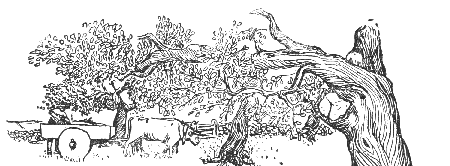
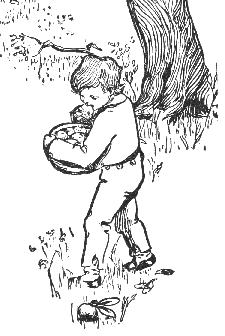
Then they stopped and Uncle John took a basket and climbed up into the tree. And he picked the apples very carefully and put them into the basket. And when the basket was full, he climbed down from the tree and emptied the basket carefully into the cart. Then he climbed up again and filled the basket again; and so he did until the cart was full. Then Uncle John said: "Gee up there;" and the old oxen started and turned around and walked slowly back to the barn and in at the big door. Then Uncle John took all the apples out of the cart and put them in a kind of pen, and the old oxen started again and walked slowly back to the orchard.
So Uncle John gathered all the apples from that tree and put them in the pen in the barn. Then he unhooked the tongue of the cart and took off the yoke, and the old oxen went to their places and went to sleep.
The next morning, Uncle Solomon and Uncle John and little John all went out to the barn, and they took little three-legged stools that had one end higher than the other,—the kind they used when they milked the cows,—and they sat on these stools and looked over all the apples, one by one. The apples that were very nice indeed they put in some barrels that were there; and the apples that were good, but not quite so nice and big, they put in a pile on the floor; and the apples that had specks on them or holes in them, or that were twisted, they put in another pile. And this last pile they gave to the horses and cows and oxen and pigs, and the apples in the barrels were to go to market, or for the people to eat.
Then Uncle John got out the old oxen and they put their heads down low, and he put the yoke over and the bows under and hooked the tongue of the ox-cart to the yoke. And he put into the cart all the apples that were in the first pile, those that were good but not quite big enough to put in the barrels, and he put two empty kegs—little barrels—on the top of the load. Then the old oxen started walking slowly along, out of the barn and along the wagon track past the shed and past the kitchen door and through the gate into the road. And they turned along the road, not the way to the field where they went to get water, but the other way. And Uncle John walked beside, and little John ran ahead, and they went along until they came to a little house by the side of the road, and there they stopped. Then Uncle John opened the door of the little house and they went in. And inside there was nothing but a log against the wall, to sit on, and in the middle of the room a kind of a thing they called a cider-press. It had a place to put the apples in, and a flat cover that came down on top, and a screw and a long handle above. Besides the cider-press, there was a chopper to chop the apples into little pieces.
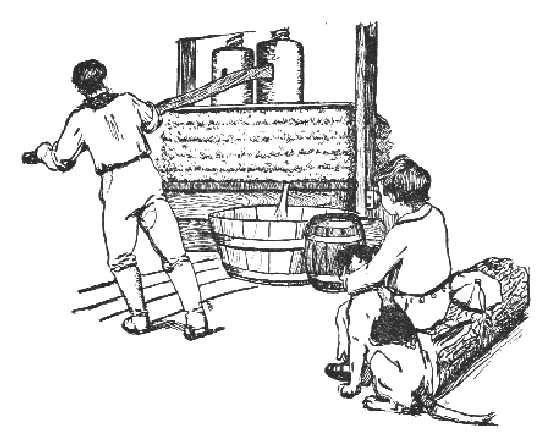
Then little John sat down on the log and Uncle John put the apples in the chopper and chopped them up fine. Then he put some chopped apples, with some straw over them, in the place that was meant for apples, and then he took hold of the long handle, and walked around and around. That made the screw turn and the cover squeeze down on the apples so that the juice ran out below into the keg that was put there. And when the juice was all squeezed out of those apples, he walked around the other way, holding the handle, and that made the cover lift up. Then he took out the squeezed apples and put in some other apples and squeezed them the same way. And when all the apples in the cart had been squeezed, both kegs were full of juice. And they call the juice cider.
So Uncle John put the great stoppers that they call bungs into the bung-holes in the kegs, so that the cider would not run out. Then he put the kegs in the cart, and little John came out of the little house and Uncle John shut the door, and the old oxen turned around and walked slowly along until they came to the gate, and they walked up the track to the kitchen door, and there they stopped. Then Uncle John and Uncle Solomon took the kegs down into the cellar, and they took out a little bung near the bottom of one of the kegs, and put in a wooden spigot—a kind of a faucet. Then they set that keg on a shelf, so that a pitcher or a mug could go under the spigot.
Then Uncle John took the yoke off the oxen and they went into the barn and went to sleep.
After supper that evening, Uncle Solomon and Uncle John were sitting in the sitting-room and Uncle John spoke to little John, and said: "John, I think I would like a drink of cider."
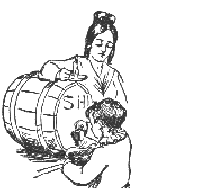

So little John took a pitcher and went down into the cellar, and his mother held a light while he put the pitcher under the spigot and turned the spigot; and the cider ran into the pitcher, and when enough had run in he turned the spigot the other way and the cider stopped running. Then he carried the cider up to his father, and his father drank it.
And when Uncle John had drunk the cider, he said to Uncle Solomon: "Father, that's pretty good cider; you'd better have some."
And Uncle Solomon said: "Don't care if I do." So little John had to go down cellar again and get another pitcher of cider.
Those two kegs of cider lasted for a while and then more apples were ripe and they made enough cider to last all winter and some to send to market besides.
And that's all.
 NCE upon a time there
was a farm-house, and
it was painted white
and had green blinds,
and it stood not far
from the road. And in
the fence was a wide gate to let the wagons
through to the barn. And the wagons,
going through, had made a little track that
went up past the kitchen door and past
the shed and past the barn and past the
orchard to a gate in a stone wall, where
the bars were across; and through that
field and another gate where the bars
were across, into the maple-sugar woods.
And in that field wheat grew.
NCE upon a time there
was a farm-house, and
it was painted white
and had green blinds,
and it stood not far
from the road. And in
the fence was a wide gate to let the wagons
through to the barn. And the wagons,
going through, had made a little track that
went up past the kitchen door and past
the shed and past the barn and past the
orchard to a gate in a stone wall, where
the bars were across; and through that
field and another gate where the bars
were across, into the maple-sugar woods.
And in that field wheat grew.
When the summer was nearly over and the corn and most of the other things had got ripe and had been gathered, Uncle John got out the old oxen and put the yoke over their necks and the bows up under; and he hooked the drag chain to the yoke and put the plough on the drag and said: "Gee up there, Buck; gee up there, Star." And the old oxen started slowly along past the barn and past the orchard to the wheat-field.
Then Uncle John took the plough off the drag and unhooked the chain from the drag and hooked it to the plough. Uncle Solomon held the handles of the plough and the old oxen started walking slowly across the field dragging the plough; and the plough dug into the ground and turned the earth up at one side and made a deep furrow where it had gone. So they went all around the field and around until it was all ploughed.
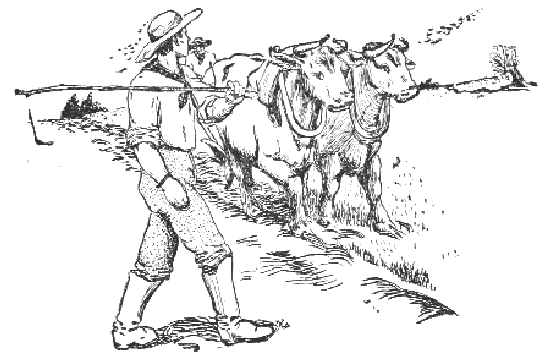
Then Uncle John unhooked the chain from the plough and hooked it to the harrow; and the old oxen started and walked slowly back and forth across the field, and the teeth of the harrow broke up the lumps of dirt and made it all soft. And when the field was all harrowed, Uncle John unhooked the chain from the harrow and hooked it to the drag and put the plough on the drag, and the old oxen walked slowly back to the barn. And Uncle John unhooked the chain and took off the yoke; and the oxen went to their places in the barn and went to sleep, and the drag was in the shed.
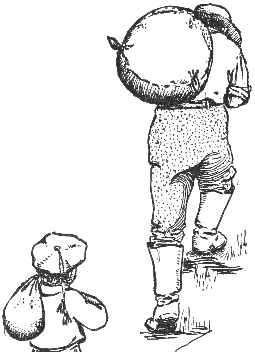
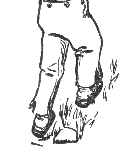
The next morning, Uncle John put some whole wheat in a big bag and put the bag over his shoulder and walked along past the orchard to the wheat-field. And when he got to the wheat-field, he put the bag down on the ground and put some of the wheat in a little bag that he had hanging from his shoulder. And then he began walking across the field, and as he walked along he took up a handful of wheat and threw it far out so that it scattered over the ground. And that way he scattered all the wheat so that it lay in the soft ground, and then he went away and left it.
And the rain fell and the sun shone on the field and the wheat began to grow. And soon the little green blades pushed up through the ground like grass; and the wheat grew higher and higher until it was as high as little John's knees. And then the summer was all over and it was beginning to get cold; so the wheat stopped growing and stayed just as high as that all winter and the snow covered it.
And when the winter was over and it began to get warm, the snow melted away and the wheat began to grow again; and it got taller and taller until it was as tall as Uncle John's waist. And then the little tassels at the top of each stem got yellow and brown and the wheat was ripe. This was in the beginning of the summer.
Then Uncle John and Uncle Solomon got their scythes and their whetstones and started very early in the morning to the wheat-field. And they sharpened their scythes with the whetstones and swung the scythes back and forth and began to cut down the wheat. Every time the scythe swung, it cut through the stalks of wheat and they fell down on the ground. And they walked along over the field, swinging the scythes and cutting down the wheat, until all the wheat was cut. Then they went home and left it lying there in the sun.
The next morning Uncle John got out the oxen and they put their heads down low, and he put the yoke over and the bows under and hooked the tongue of the cart to the yoke and said "Gee up there." And the old oxen walked slowly along, past the barn and past the orchard to the wheat-field.
And the sun had dried the stalks of wheat and the tassels. The tassels are a lot of little cases, on a fine stem; and in each little case is a grain of whole wheat. When the tassels are dry, the little cases are all ready to break open.
Then Uncle Solomon and Uncle John took their long forks and put the wheat in the cart, and when the cart was full the old oxen walked slowly back to the barn and in at the great doors.
There were great enormous doors in the side of the barn, big enough for a wagon to go through when it was piled up high with a load of hay or of wheat. And in the other side of the barn were other great enormous doors, so that the wagon could go right through the barn; and between the doors was only the great open floor with nothing on it. On one side of this open place were the cows, and on the other side were the horses and the oxen, and the cart went in between, with the wheat in it.
Then Uncle Solomon and Uncle John took the wheat out of the cart and put it on the floor of the barn; and the old oxen started again and walked out the other door and back to the wheat-field. Then Uncle Solomon and Uncle John filled the cart again and the oxen dragged that wheat to the barn; and they did the same way until all the wheat was on the barn floor. Then Uncle John took off the yoke and the old oxen went to their places and went to sleep.
The next morning Uncle Solomon and Uncle John went to the barn, and each took down from a nail a long smooth stick that had another smooth stick fastened to its end by a piece of leather so that it flapped about. This was to beat the wheat with, and they called it a flail.
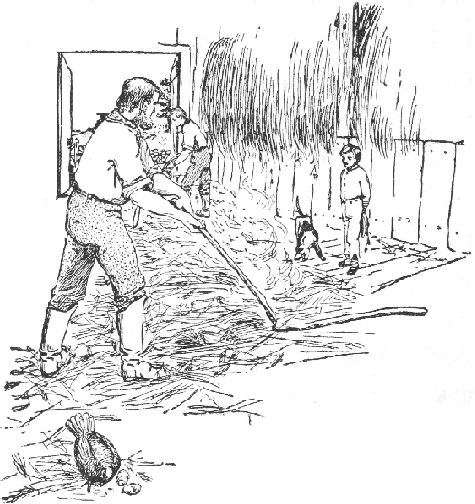
And so Uncle Solomon and Uncle John stood in amidst the wheat on the barn floor and whacked it with the flails so that they made a great noise—whack! whack!—on the floor. And the little cases broke open and the grains of whole wheat fell out and dropped between the stalks to the barn floor. And the pieces of the broken cases blew out from the great barn doors; for the doors were open at both sides and the wind blew through. These broken pieces that blow away, they call chaff.
Then when Uncle Solomon and Uncle John had whacked for a long time, and they thought that all the whole wheat had come out of the cases, they hung up the flails and took their long forks and lifted up the stalks of the wheat and shook them so that all the grains of wheat might drop through; and they put the dried stalks of the wheat in a corner of the hay-loft above where the cows slept. These dried stalks they call straw, and they put it for the horses and the cows and the oxen to sleep on.
And when the straw was all put away, there was all the wheat on the floor; and they gathered it up and put it into bags. And they had enough to make whole wheat flour to last all winter, and to feed the chickens and every kind of a thing that they wanted to use wheat for, and there was enough to take some to market besides.
And that's all.
 NCE upon a time there
was a farm-house, and
it was painted white
and had green blinds.
And when this farm-house
was just built,
before it was Uncle Solomon's, the man
that lived there wanted some fields where
he could plant his corn and his potatoes
and his wheat. But the places where the
fields would be were all covered with trees.
NCE upon a time there
was a farm-house, and
it was painted white
and had green blinds.
And when this farm-house
was just built,
before it was Uncle Solomon's, the man
that lived there wanted some fields where
he could plant his corn and his potatoes
and his wheat. But the places where the
fields would be were all covered with trees.
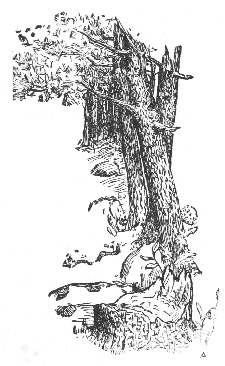
So in the winter when the snow was on the ground, he went out and cut down the trees with his axe. And the great big trees he carried to the mill, and they were sawed up into boards; that is another story. And the branches and the small trees he chopped up with his axe to burn in the fireplaces. Then the field was all covered with the stumps of the trees and with great rocks.
Then, when it began to get warm, after the winter was over, the man got out the old oxen. There were two pairs of oxen, and they came out of the barn and put down their heads, and the man put the yokes over their necks and the bows up under, and he hooked great chains to the yokes. And he hooked one chain to the drag, and took his whip and said: "Gee up there, Buck; gee up there, Star." And the old oxen began walking slowly along to the field.
Then the man unhooked the drag, and fastened one of the chains to a stump, and hooked the other chain to that chain, and said: "Gee up there." And all the oxen began to pull as hard as they could, and all of a sudden out came the stump with a lot of dirt. And he pulled out all the stumps the same way, and stood them up at the back of the field, where they made a kind of a fence with the roots sticking slanting up into the air.
Then there were the big rocks all over the field. And the man fastened the chains to a rock and the old oxen pulled as hard as they could, and out came the rock and they put it on the drag. And then the man saw where he wanted his fence; and they dug a trench and put flat rocks on the bottom and then the biggest rocks they had on the flat rocks. And they pulled all the rocks out of the ground with the chains, and put them on the drag, and the old oxen pulled them over to the trench, and the man piled them up and built a wall.
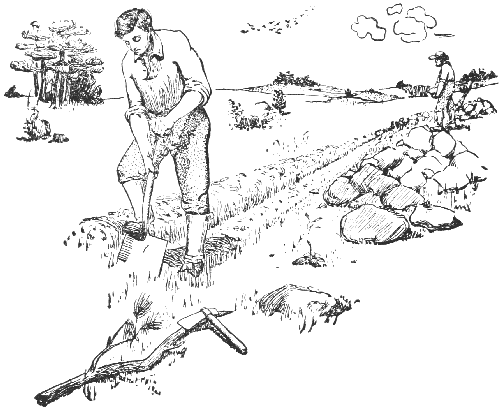
Building the wall took a long time—a good many days. And when the oxen had pulled all the rocks out of the ground and dragged them over to the wall, the field was all soft and ready to be ploughed. So the oxen started walking along, out of the field, along the road, dragging the drag. And they went in at the big gate and up past the kitchen door to the barn. Then the man unhooked the chains and took off the yokes and the oxen went into the barn and went to sleep.
And that's all.
 NCE upon a time there
was a farm-house, and
it was painted white
and had green blinds;
and it stood not far
from the road. In the
fence was a wide gate to let the wagons
through to the barn. And the wagons,
going through, had made a little track that
went up past the kitchen door and past
the shed and past the barn and past the
orchard to the wheat-field. Not very
far from that farm-house there was a
field where the horses and cows used to
go to eat the grass. That was the same
field where they went to get water from
the river; and in the wall that was
between that field and the next, there was
a wide gateway. At each side of the gateway
there was a post with holes in it, and
long bars went across and rested in the
holes. And when the bars were across,
the horses and cows couldn't go through
to the other field. But when the bars
were taken out of the holes, then the
horses and cows could go through as
much as they wanted to and eat the grass
in either field.
NCE upon a time there
was a farm-house, and
it was painted white
and had green blinds;
and it stood not far
from the road. In the
fence was a wide gate to let the wagons
through to the barn. And the wagons,
going through, had made a little track that
went up past the kitchen door and past
the shed and past the barn and past the
orchard to the wheat-field. Not very
far from that farm-house there was a
field where the horses and cows used to
go to eat the grass. That was the same
field where they went to get water from
the river; and in the wall that was
between that field and the next, there was
a wide gateway. At each side of the gateway
there was a post with holes in it, and
long bars went across and rested in the
holes. And when the bars were across,
the horses and cows couldn't go through
to the other field. But when the bars
were taken out of the holes, then the
horses and cows could go through as
much as they wanted to and eat the grass
in either field.
One day little John was going across the field because it was the short way; and there was a horse in the field, eating the grass, and the bars were down. It was a kind, pleasant horse, but he liked to have fun. And when he saw the little boy going across the field, he thought he would have fun, so he ran after him.
Little John saw the horse coming and he was frightened. He was near the wall that was between the two fields, and he ran as hard as he could and got to the wall before the horse caught him. Then he began to climb over the wall into the next field.
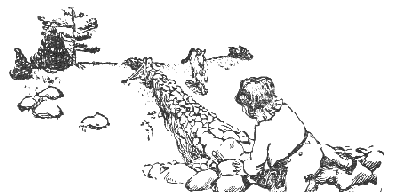
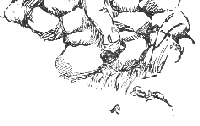
And the horse saw what he was doing and ran down the field, beside the wall, and through the gate and back on the other side; and he got there just as the little boy was getting down. And little John heard the horse's feet on the ground—ca-tha-lump—ca-tha-lump—ca-tha-lump— and he looked around and he saw the horse galloping up by the wall. Then he was frightened and he began to climb back again over the wall as fast as he could.
And the horse saw what he was doing and ran down the field, beside the wall, and through the gate and back on the other side; and he got there just as the little boy was getting down. And little John heard the horse's feet on the ground—ca-tha-lump—ca-tha-lump—ca-tha-lump— and he looked around and he saw the horse galloping up by the wall. Then he was frightened and he began to climb back again over the wall as fast as he could.
And the horse saw what he was doing and ran down the field, beside the wall, and through the gate and back on the other side; and he got there just as the little boy was getting down. And little John heard the horse's feet on the ground—ca-tha-lump—ca-tha-lump—ca-tha-lump— and he looked around and he saw the horse galloping up by the wall. Then he was frightened and he began to climb over the wall again. But every time he had climbed over the wall between the fields, he had gone a little nearer to the road, until he was near enough to the wall between the field and the road to reach that. And this time, instead of climbing back into the other field, he climbed over into the road.
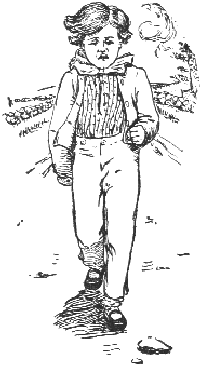
And poor little John was very much frightened and ran along the road crying, and got home, and his father saw him and asked him: "What's the matter, John?" And then little John told his father about the horse. And his father laughed and said that the horse was a kind horse but he liked to have fun; and little John better not go there any more. And so the little boy did not go through that field again, but went around by the road.
And that's all.
 NCE upon a time there
was a farm-house, and
it was painted white
and had green blinds;
and it stood not far
from the road. In the
fence was a wide gate to let the wagons
through to the barn. And the wagons,
going through, had made a little track that
went up past the kitchen door and past
the shed and past the barn and past the
orchard to the wheat-field. But when
this farm-house was just built, there
wasn't any wheat-field or any other field,
and the places where the fields would be
were all covered with trees. And that
was a long time before Uncle Solomon
had the farm.
NCE upon a time there
was a farm-house, and
it was painted white
and had green blinds;
and it stood not far
from the road. In the
fence was a wide gate to let the wagons
through to the barn. And the wagons,
going through, had made a little track that
went up past the kitchen door and past
the shed and past the barn and past the
orchard to the wheat-field. But when
this farm-house was just built, there
wasn't any wheat-field or any other field,
and the places where the fields would be
were all covered with trees. And that
was a long time before Uncle Solomon
had the farm.
So the man that built the farm-house took his axe, one day, when the snow was on the ground, and he went to the place where he wanted the fields and he began to cut down the trees. There were big trees and little trees, and it took him a long time to cut down all the trees on the place where the field would be. He cut off all the branches, and the branches and the little trees he cut up with his axe to burn in the fireplaces; and he piled all that wood near the kitchen door. But the big logs—the trunks of the big trees after the branches were cut off—he was going to take to the mill, to have them sawed into boards.
So, one morning, after that was all done, the man got out the oxen. There were two yoke of oxen—two oxen they call a "yoke" of oxen, because two are yoked together—and they came out of the barn and put their heads down and he put the yokes over and the bows under and he hooked the tongue of a great sled to each yoke. And on each sled was a great chain.
Then he said: "Gee up there," and the oxen all started walking slowly along, and they walked out of the wide gate and along the road until they came to the place where the trees were all cut down, and there they stopped. And the sleds were beside one of the big logs, one sled at each end.
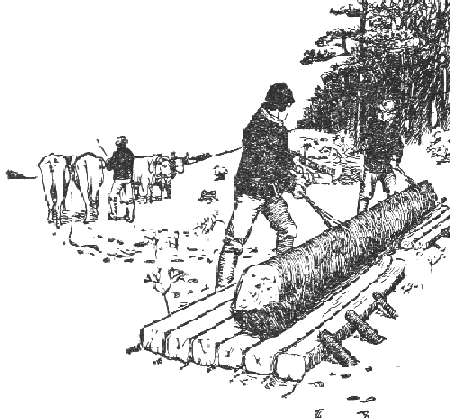
Then they unhooked the tongues of the sleds from the yokes and led the oxen out of the way. And the man and two other men that were helping him put some little logs sloping from the ground up to the sleds, and with poles that had hooks on the ends they rolled the great log up the little logs on to the sleds, so that it rested on them. And there was one sled under each end, but under the middle there was nothing. Then they fastened that log to the sleds, so that it couldn't roll off, and they rolled another log up on the other side and fastened that; and they rolled another log up on top of the first two. Then they fastened the tongue of each sled to the logs, and the logs were held on with the great chains, so they couldn't roll off. Then they hooked a chain to the first sled and to one of the yokes, and another chain from that yoke to the other yoke. And the man said: "Gee up there," and all the oxen pulled as hard as they could, and the sleds started sliding along the ground on the snow and into the road. And the oxen walked slowly along the road, pulling the sleds with the logs on them, for a long way.
When they had gone along the road for a long way, they came to a place where there was a building beside a little river. And on the side of the building was a wheel so large that it reached down into the water. And when the water ran along, it made the wheel turn around and that made a big saw go, inside the building.
And the oxen pulled the sleds with the logs up beside the building and there was a strong carriage that ran on wheels on a track. And the men unfastened the chains and rolled a log off on to the carriage and fastened it there. Then they pushed on the carriage and it rolled along toward the saw, and the saw was going.
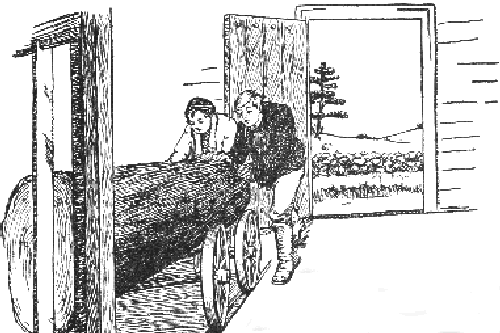
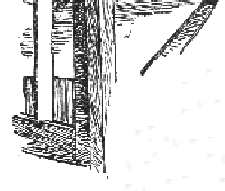
And the end of the log came against the saw and the saw made a great screeching noise and began to cut into the log, and it kept on cutting and the men pushed, and the saw cut all the way through the log, to the other end, and that piece fell off. That piece was round on one side and flat on the other.
Then they rolled the carriage back and fastened the log farther over and pushed it up against the saw again, and the saw cut off another piece that was flat on both sides. That piece was a board. And that way they cut the log all up into boards, and then they cut up the other logs the same way.
When the logs were all cut into boards, the men put the boards on the sleds and fastened them on just the same way the logs had been fastened, and the oxen started and turned around and walked along the road until they came to the farm-house; and they turned in at the gate and went up past the kitchen door to the place where the shed was going to be, and there they stopped. And the men took the boards off and put them on the ground in a pile, so that the man would have them there to build the shed. For the shed wasn't built then. The barn was built first and then the house.
And the other big logs they took to the saw-mill on other days and sawed them up into boards, so that the man had all the boards he needed to build the shed and the chicken house and all the other things and some to give to the men for helping him.
And when that was done, the man took off the yokes and the old oxen went into the barn and went to sleep.
And that's all.
 NCE upon a time there
was a farm-house, and
it was painted white
and had green blinds;
and it stood not far
from the road. In the
fence was a wide gate to let the wagons
through to the barn. And the wagons,
going through, had made a track that led
up past the kitchen door and past the
shed and past the barn and past the orchard
to the wheat-field.
NCE upon a time there
was a farm-house, and
it was painted white
and had green blinds;
and it stood not far
from the road. In the
fence was a wide gate to let the wagons
through to the barn. And the wagons,
going through, had made a track that led
up past the kitchen door and past the
shed and past the barn and past the orchard
to the wheat-field.
In that farm-house lived Uncle Solomon and Uncle John; and little Charles and little John and their mother Aunt Deborah; and little Sam and his mother Aunt Phyllis. Uncle Solomon was Uncle John's father and Uncle John was little John's father, so that Uncle Solomon was little John's grandfather. And little Sam was Uncle Solomon's little boy, so that little Sam was little John's uncle. But little Sam was a littler boy than little John.
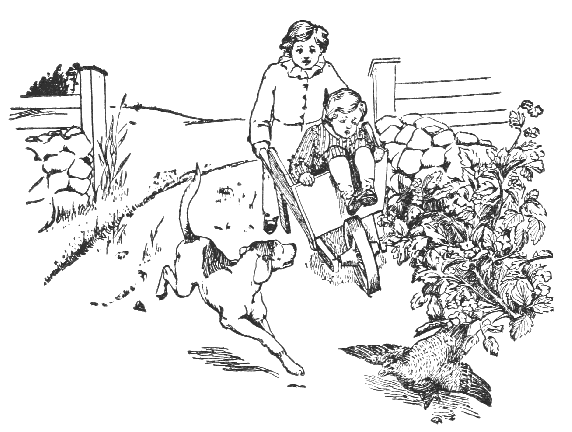
Little John and Uncle Sam used to play together; and one day when little John was wheeling Uncle Sam in the wheelbarrow, he thought it would be fun to tip him out. So he tipped Uncle Sam right out into some bushes, and Uncle Sam scratched his face and began to cry. And Uncle Solomon heard his little boy crying, and he came running out of the house. Then he saw little John and the wheelbarrow, and little Sam in the bushes, crying, and he knew that little John had tipped little Sam out of the wheelbarrow.
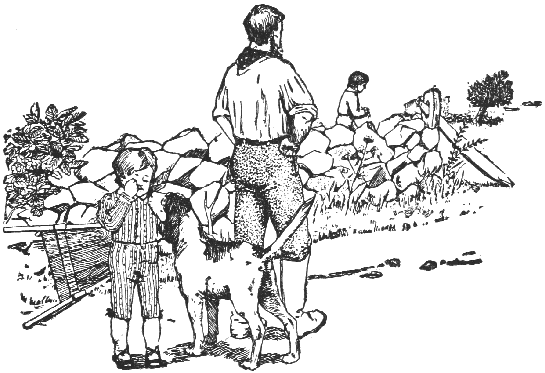
So Uncle Solomon was angry, and he grabbed little John by the back of his collar and the back of his trousers, and he lifted him up and gave him a great swing, and he tossed little John right over the wall. And little John came down in some bushes and got his face scratched a little, but he didn't cry. He just got up and ran around the wall and went into the house another way, and kept out of Uncle Solomon's way. But he didn't tip Uncle Sam into the bushes any more.
And that's all.
 NCE upon a time there
was a farm-house, and
it was painted white
and had green blinds;
and it stood not far
from the road. In the
fence was a wide gate to let the wagons
through to the barn. And the wagons,
going through, had made a track that led
up past the kitchen door and past the
shed and past the barn and past the orchard
to the wheat-field.
NCE upon a time there
was a farm-house, and
it was painted white
and had green blinds;
and it stood not far
from the road. In the
fence was a wide gate to let the wagons
through to the barn. And the wagons,
going through, had made a track that led
up past the kitchen door and past the
shed and past the barn and past the orchard
to the wheat-field.
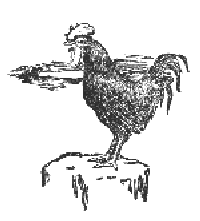
One morning, after the summer was over and all the different things had got ripe and had been gathered, Uncle John woke up when the old rooster crowed, very early, long before it was light. And he got up and put on his clothes, and Aunt Deborah got up too, and they went down-stairs.
Then, while Aunt Deborah fixed the fire and got breakfast ready, Uncle John went out to the barn. He gave the horses their breakfast, and when they had eaten it he took them out of their stalls and put the harness on and led them out to the shed. Then he hitched them to the big wagon and he made them back the wagon up to the place where all the things were put that were to go to market.
Then Uncle Solomon came out and helped, and they put into the wagon all the barrels of apples that they could get in, and they put in a lot of squashes and turnips and some kegs of cider and some bags of meal and fine hominy and some butter that Aunt Deborah and Aunt Phyllis had made and some other things. And when these things were all in the wagon, breakfast was ready, and Uncle John fastened the horses to a post and went in to breakfast. And all this they had to do by the light of a lantern, because it wasn't daylight yet.
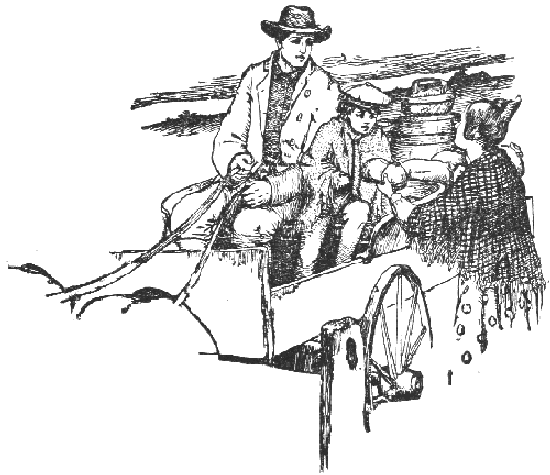
Then, when Uncle John and little John had had their breakfast, they came out of the house, and Uncle John put little John up on the high seat and he unhitched the horses and climbed up on the high seat beside him. And then Aunt Deborah came out of the house and handed Uncle John a little bundle, and he put the bundle under the seat. In the bundle was some luncheon for Uncle John and little John; and for the horses there was some luncheon too, oats in a pail that hung under the wagon, one pail for each horse. And a lantern hung beside the seat, for it wasn't daylight yet.
When they were all ready, Uncle John said: "Get up," and the horses started walking down the little track into the road and along the road. The horses wanted to trot, but Uncle John wouldn't let them because it isn't good for horses to trot when they have just had their breakfast; and he held on to the reins tight and they had to walk. So they walked along for awhile and it was very dark; and pretty soon Uncle John let the horses trot. And they trotted along the road for a long time and at last it began to get light, and little John was very glad, for he was cold. Then Uncle John blew out the lantern and after awhile the sun came up and shone on them and made them warm. And the horses trotted along for a long time and at last they began to come to the city, and it was very early.
So the horses dragged the wagon through the city streets, and there were not many people in the streets, for they had not had their breakfasts. And by and by they came to the shops and little John saw the boys opening the doors of the shops and sweeping the shops and the sidewalks; and so they went along until they came to a great open place. And in the middle of the open place was a big building, and all about it were wagons, some standing in the middle of the street and some backed up to the curbstone. All these wagons had come in from the country, bringing the things to eat; and the building was a market, and the men in the market bought the things from the men that drove the wagons, and the people that lived in the houses came down afterward and bought the things from the market-men.
Then Uncle John drove the horses up to the sidewalk and he got out and hitched the horses to a post and told little John not to get off the seat; and Uncle John went into the market. When he had been gone some time, he came back and a market-man came with him. The market-man had a long white apron on and no coat; and he looked at the barrels of apples and the squashes and the turnips and the kegs of cider and the bags of meal and the butter and the other things, and he thought about it for a few minutes and then he said: "Well, I'll give you twenty dollars for the lot."
And Uncle John thought for a few minutes and then he said: "Well, I ought to get more for all that. It's all first-class. But I suppose I'd better let it go and get back."
So Uncle John unhitched the horses and backed the wagon up to the sidewalk. Then he took the bridles off the horses' heads and took the buckets of oats from under the wagon; and he put the pails on boxes at the horses' heads, one for each horse, and the horses began to eat the oats.
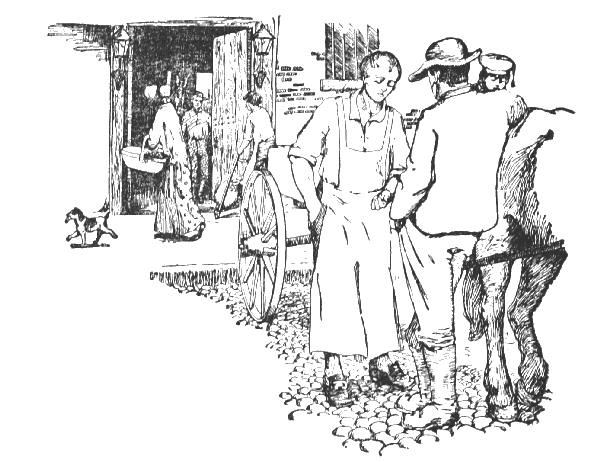
Then a man came out of the market, wheeling a truck—a kind of a little cart with iron wheels—and he helped the market-man take the barrels out of the wagon, and the squashes and turnips and the kegs of cider and the bags of meal and the butter and the other things. And they put them on the truck, a part at a time, and he wheeled them into the market. Then, when that was all done, the market-man took some money from his pocket and counted twenty dollars and handed it to Uncle John. And then the horses had finished eating the oats, and Uncle John took the pails and hung them under the wagon again and put the bridles on the horses' heads.
Then Uncle John climbed up on the high seat beside little John and took the reins in his hands and said "Get up"; and the horses started and went across the open place to a great stone that was hollowed out and was full of water. And the horses each took a great drink of water and then they lifted up their heads and started along the streets.
And pretty soon Uncle John stopped them at a shop, and he went in and bought some things that Aunt Deborah wanted, and he paid the shop-man some of the money the market-man had given him. Then they went to another shop and Uncle John bought some more things. And after that they didn't stop at any shops, but the horses trotted along through the streets until they were out of the city and going along the road in the country that led to the farm-house.
By and by they came to a steep hill and the horses stopped trotting and walked, for they were tired. And Uncle John fastened the reins and took the bundle from under the seat and undid it, and in it were bread and butter and hard eggs and gingerbread and a bottle of nice milk. And Uncle John and little John ate the nice things and liked them, for they were both very hungry.
Then they got to the top of the hill and Uncle John took up the reins again and said "Get up," and the horses trotted along for a long time until they came to the farm-house; and they turned in at the wide gate and went up to the kitchen door and there they stopped. And Uncle John got down and took little John down. Little John was glad to get off the high seat, for he had been there a long time and he was very tired.
So he went into the house and Uncle John unhitched the horses from the wagon and put the wagon in the shed. And he took the horses to the barn and took off their harness and put them in their stalls, and they went to sleep.
And that's all.
 NCE upon a time there
was a farm-house, and
it was painted white
and had green blinds;
and it stood not far
from the road. In the
fence was a wide gate to let the wagons
through to the barn. And the wagons,
going through, had made a track that led
up past the kitchen door and past the
shed and past the barn and past the orchard
to the wheat-field; and through the
wheat-field to the maple-sugar woods.
NCE upon a time there
was a farm-house, and
it was painted white
and had green blinds;
and it stood not far
from the road. In the
fence was a wide gate to let the wagons
through to the barn. And the wagons,
going through, had made a track that led
up past the kitchen door and past the
shed and past the barn and past the orchard
to the wheat-field; and through the
wheat-field to the maple-sugar woods.
One day, when the winter was almost over and it was beginning to get warmer, Uncle John got out the old oxen. And they came out and put their heads down and he put the yoke over and the bows under, and he hooked the tongue of the sled to the yoke; for the snow was not all melted, and enough was on the ground for the sled to go on.
Then he put on the sled his axe and Uncle Solomon's, and a lot of buckets and a lot of wooden spouts he had made, and the big saw. Then he put little John on the sled and said "Gee up there," and Uncle Solomon came too, and they walked along beside the sled. And the old oxen walked slowly along the track past the barn and past the orchard to the wide gate that led into the wheat-field, and there they stopped. And Uncle John took down the bars and the oxen went through the gate and across the wheat-field, and stopped at the wide gate on the other side of the field. Then Uncle John took down those bars and the old oxen started and walked through and along the little road in the maple-sugar woods until they came to a little house beside the road, and there they stopped.
Then Uncle John opened the door of the little house; and inside, it was about as big as a little room that a little boy sleeps in. And in one corner was a chimney, and in front of the chimney was a great enormous iron kettle, set up on a little low brick wall that was just like a part of the chimney turned along the ground. In the front was a hole in the low wall, so that wood could be put in, and at the back, under the kettle, there was a hole into the chimney, so that the smoke would go up the chimney and out at the top. And in one corner of the little house were some square iron pans.
Then Uncle John put two of the buckets down in the house, and the big saw; and he shut the door and the oxen started and walked along until they came where were some maple-sugar trees, and there they stopped. Then Uncle John and Uncle Solomon took their axes and went to the trees and they made little notches in the trees, low down, so that there was room to put a bucket under. And they drove a spout in each notch and put a bucket under each spout. And then they went to other trees and made a notch in each tree and drove in a spout and put a bucket under and so they did until they had used up all their buckets.
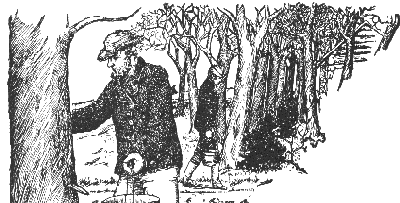
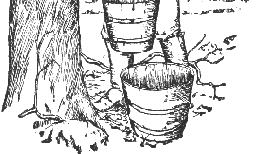
Then the old oxen walked along until they came to a pile of wood that was cut up all ready to burn; and there they stopped and Uncle Solomon and Uncle John put the wood on the sled. Then they said: "Gee up," and the oxen walked back to the little house, and they took the wood off the sled. And the wood was in great long sticks, too long to put in the place under the kettle. So Uncle John got the big saw from the little house and he and Uncle Solomon sawed the wood into small sticks and piled it up nicely.
Then they put the saw on the sled and shut the door of the little house and the old oxen started walking back along the little road, dragging the sled, with the saw and the axes and little John. And they went through the gate into the wheat-field and Uncle John put the bars back; and they went across the wheat-field and through the gate at the other side, and Uncle John put those bars back. And they walked along past the orchard and past the barn to the shed.
And Uncle John unhooked the tongue of the sled and took off the yoke, and the old oxen went into the barn and went to sleep.
The next morning, Uncle John and little John started along the little road, past the shed and past the barn and past the orchard; and they climbed over the bars into the wheat-field, and went through the wheat-field and climbed over the bars into the maple-sugar woods. Then they walked along until they came to the little house, and Uncle John opened the door of the house and took out the two buckets he had left there.
Then they went to some of the maple-sugar trees where they had put buckets the day before, and the sap was dripping slowly into the buckets—drip—drop—drip—drop—and the buckets were nearly half full. So Uncle John poured the sap from those buckets into the empty buckets and went along to some other trees and poured the sap from those buckets in with the other, and the buckets he carried were full. So he took them back to the little house and emptied them into the big kettle.
Then he went to other trees and filled the two buckets again with the sap that had dripped, and emptied that into the kettle. And so he did until he had taken all the sap that had dripped.
Then he put wood under the big kettle and lighted it, and the fire burned and the sap got hot and after a while it began to boil. And while it was boiling, Uncle John stirred the sap once in a while with a wooden stirring thing he had made. And when it had boiled a long time, he dipped out a little with the stirrer and went to the door and dropped it in the snow, so that when it got cool he could see whether it was boiled enough. But it wasn't done enough, and he let it boil longer, and then he dropped some more in the snow; and this time he thought it was about right for maple-syrup.
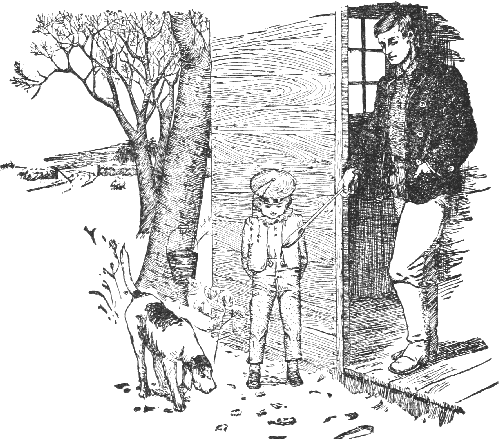
So he dipped sap out of the kettle into a keg that was in the little house, until the keg was full. And then he put the bung into the bung-hole and set the keg in the corner.
Then Uncle John put more wood on the fire and the sap boiled a long time. And at last he thought it was done enough for maple-sugar; and he dipped some out with the stirrer and went to the door and dropped it in the snow. And when it got cold, he saw that it was hard, and was just right for maple-sugar. So he took the little square pans that were in the corner of the house and he dipped the boiled sap from the kettle into the pans and set them in the snow outside.
Then he let the fire go out, and when the sugar in the pans was hard, he brought it into the house, and shut the door and started along the little road, and little John after. They walked along through the maple-sugar woods and climbed the bars into the wheat-field, and walked across the wheat-field and climbed the bars at the other side, and walked along past the orchard and past the barn and past the shed to the kitchen door, and there they went in.
The next morning, Uncle John and little John went to the maple-sugar woods again, and Uncle John got some more sap and boiled it and made maple-syrup and maple-sugar. And so they did every day until they had taken all the sap that the trees ought to give.
Then Uncle John got out the old oxen and they put their heads down and he put the yoke over and the bows under, and he hooked the tongue of the sled to the yoke. Then he said "Gee up there," and the oxen started walking along past the barn and past the orchard, and Uncle John took down the bars at the wheat-field and they went through and across the field, and he took down the bars at the other side and they walked through and along the road in the maple-sugar woods until they came to the little house.
There they stopped, and Uncle John opened the door and put the kegs on the sled, and all the little squares of maple-sugar and all the buckets and all the spouts that he had pulled out of the trees. And he shut the door of the little house, and the oxen started and walked back along the road through the maple-sugar woods into the wheat-field, and Uncle John put up the bars. And they walked across the wheat-field and through the gate at the other side, and Uncle John put up those bars; and they walked along past the orchard and past the barn, and little John came after.
Then the old oxen dragged the sled to the place where they kept the things that were to go to market, and Uncle John took off the maple-syrup and the maple-sugar and put them in that place. But some of the maple-syrup and some of the maple-sugar he put in the cellar for themselves to use; for little Charles and little John and little Sam liked maple-sugar and they liked maple-syrup on bread. And there was enough maple-syrup and maple-sugar to last them a long time and a lot to go to market besides.
Then Uncle John unhooked the tongue of the sled from the yoke and put the sled in the shed; and he took off the yoke and the old oxen went into the barn and went to sleep.
And that's all.
 NCE upon a time there
was a farm-house, and
it was painted white
and had green blinds;
and it stood not far
from the road. In the
fence was a wide gate to let the wagons
through to the barn. And the wagons,
going through, had made a track that led
up past the kitchen door and past the
shed and past the barn and past the orchard
to the wheat-field; and through the
wheat-field to the maple-sugar woods.
NCE upon a time there
was a farm-house, and
it was painted white
and had green blinds;
and it stood not far
from the road. In the
fence was a wide gate to let the wagons
through to the barn. And the wagons,
going through, had made a track that led
up past the kitchen door and past the
shed and past the barn and past the orchard
to the wheat-field; and through the
wheat-field to the maple-sugar woods.
All about were other fields; and one of them was a great enormous field where Uncle John used to let the horses and cows go to eat the grass, after he had got the hay in. This field was so big that Uncle John thought it would be better if it was made into two fields. He couldn't put a stone wall across it, because all the stones in the field had been made into the wall that went around the outside. So he thought an easy way would be to put a rail fence across.
So, one day, when it was winter and snow was on the ground, Uncle John and Uncle Solomon took their axes and walked along the little track, past the barn and past the orchard, and climbed over the bars into the wheat-field. Then they walked across the wheat-field and climbed over the bars into the maple-sugar woods; and they walked along the road in the woods until they came to a place where were some trees that were just the right size to make rails and posts. They were not maple-sugar trees, but a different kind.
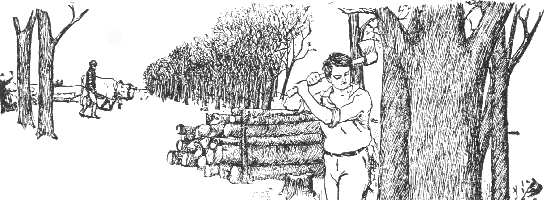
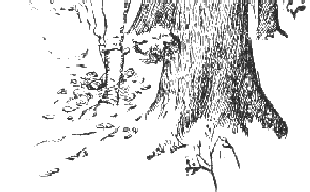
Then they cut down enough of these trees to make all the rails and all the posts they wanted; and they cut off all the branches and they cut some of the trees into logs that were just long enough for rails, and they cut the other trees into logs that were just long enough for posts. Then they took the rail logs and with their axes they split each one all along from one end to the other, until it was in six pieces. Each piece was a rail. But the post logs they didn't split.
Then they left the logs and the rails lying there and walked back, and climbed over into the wheat-field, and went across the wheat-field and climbed over at the other side, and walked past the orchard and past the barn and past the shed and went in at the kitchen door.
The next morning, Uncle John got out the old oxen, and they put their heads down low, and he put the yoke over and the bows under, and hooked the tongue of the sled to the yoke. Then he said: "Gee up there," and they started walking slowly along, past the barn and past the orchard to the wheat-field; and Uncle John took down the bars and they walked across the wheat-field, and he took down the bars at the other side. Then the old oxen walked through the gate and along the road to the place where the post logs and the rails were; and Uncle Solomon had come too, and little John. But they didn't let little John come when they cut the trees down, because they were afraid he might get hurt.
Then Uncle Solomon and Uncle John piled the rails on the sled, and the post logs on top, and the old oxen started and walked along the road and through into the wheat-field and across the field, and Uncle John put the bars up after the oxen had gone through the gates. Then they dragged the sled along past the orchard and past the barn to the shed. There they stopped and Uncle John and Uncle Solomon took off the logs and the rails. The rails were piled up under the shed, to dry; but the logs they had to make square, and holes had to be bored in them before they would be posts. Then Uncle John unhooked the tongue of the sled from the yoke and took off the yoke, and the old oxen went into the barn.
The next day, Uncle John took an axe that was a queer shape, and he made the post logs square. Then he bored the holes in the logs for the rails to go in, and piled the posts up under the shed. They were all ready to set into the ground, but the ground was frozen hard, and they couldn't be set until the winter was over and the ground was soft.
After the winter was over and it was getting warm, the ground melted out and got soft. Then Uncle John and Uncle Solomon took a crowbar—a great, heavy iron bar with a sharp end—and a shovel, and they went to the great enormous field. Then they saw where they wanted the fence to be, and they dug a lot of holes in the ground, all in a row, to put the posts in.
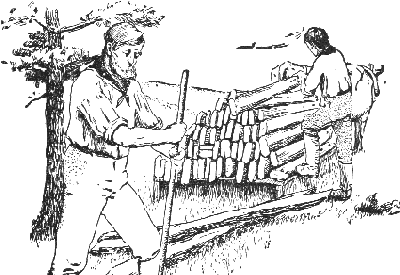

Then they went back and Uncle John got out the oxen and put the yoke over and the bows under and hooked the tongue of the cart to the yoke. On the cart they piled the posts, and there were so many they had to come back for another load. Then the oxen started and walked down the little track and out through the wide gate into the road, and along the road to the great enormous field where the holes were all dug for the posts. Then Uncle Solomon and Uncle John put the posts in the holes and pounded the dirt down hard.
Then the oxen walked back along the road to the farm-house and in at the gate and up to the shed. And Uncle John put the rails on the cart and the oxen walked back to the field again and in beside the row of posts. And Uncle John took the rails off the cart and put them in the holes in the posts, so that they went across from one post to the next. And in each post were four holes, and four rails went across.
Then the oxen went a little farther and the rails were put in between the next posts, and so on until the rails reached all the way across the field, and the fence was done. And when Uncle John wanted the cows or the horses to go through, he could take down the rails at any part of the fence.
Then the old oxen started walking back out of the field into the road and along the road to the farm-house. And they went in at the wide gate and up the track past the kitchen door to the shed, and there they stopped.
And Uncle John unhooked the tongue of the cart from the yoke and put the cart in the shed. And he took off the yoke and the old oxen went into the barn and went to sleep.
And that's all.
 NCE upon a time there
was a farm-house, and
it was painted white
and had green blinds;
and it stood not far
from the road. In the
fence was a wide gate to let the wagons
through to the barn. And the wagons,
going through, had made a track that led
up past the kitchen door and past the
shed and past the barn and past the orchard
to the wheat-field.
NCE upon a time there
was a farm-house, and
it was painted white
and had green blinds;
and it stood not far
from the road. In the
fence was a wide gate to let the wagons
through to the barn. And the wagons,
going through, had made a track that led
up past the kitchen door and past the
shed and past the barn and past the orchard
to the wheat-field.
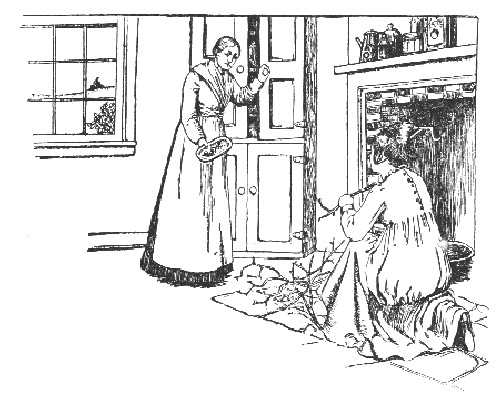
One morning, the old rooster crowed very early, as soon as it began to be light. And that waked Uncle John and Aunt Deborah, and Uncle Solomon and Aunt Phyllis. And they all got up and put on their clothes and came down-stairs. Then Aunt Deborah and Aunt Phyllis went about their work in the kitchen, getting things for breakfast and fixing the fire; and Uncle Solomon and Uncle John went out to the barn. Uncle Solomon looked after the horses and gave them their breakfast, and Uncle John looked after the cows.
Between the two great doors of the barn there was a great open place so that the wagons could go right through; and that was where they threshed the wheat. And on one side were the stalls for the horses and the places for the oxen, and on the other side were the places for the cows. In the corner of the barn next to the horses was the harness-room, and in the corner next to the cows was the milk-room.
There were two big horses and two big oxen and six cows. The horses were in stalls, but the cows didn't have stalls. They stood in a row on a kind of a low platform, with their heads toward the open place in the middle of the barn. Each cow had her head through a kind of frame made of two boards that went up from the floor, so that when the boards were fastened at the top she couldn't get her head out, but she could move it up and down all she wanted to. And when they wanted to let the cows out, they unfastened one of the boards and let it down. But Uncle John didn't like the frames for the cows, so he never fastened the boards at all, but he put a chain around the neck of each cow and hooked the other end to a post.
In front of each cow was a little low wall, about as high as her neck, and just behind the wall was a trough that they call a manger, where they could put hay or meal or other things for the cow to eat, so that she could reach it. Just over the manger of each cow was a hole in the floor of the loft where the hay was, so that they could put hay through and it would fall right into the manger, in front of the cow. In winter the cows had hay, but in summer they didn't have hay, because they could eat the grass, and that was better.
So, when Uncle John went to look after the cows, he didn't climb up to the loft and pitch some hay down through the holes, as he would do in winter, but he took a wooden measure and went to a big box that they call a bin. It stood in the corner next to the milk-room, and it was full of meal that was ground up from corn at the mill. And he gave each cow a measureful of meal and put it in the manger so that she could eat it.
Then he went to the milk-room and got the big milk pails and his milking-stool. The milking-stool was a little stool that had three legs, and one of the legs was shorter than the other two, so that it sloped.
Then Uncle John put the milking-stool down by a cow, and the pail was between his knees, resting on the end of the stool. And he milked the cow and the milk spurted into the pail. And when she had given all the milk she had, the pail was about half full.
Then Uncle John went to the next cow and milked her, and when that pail was full, he took the other pail. And so he milked all the cows, one after the other, and when both the pails were full, he took them to the milk-room and poured the milk through a strainer into a big can. And the cows were eating their meal all the time they were being milked.
At the side of the barn, behind the cows, was a door that opened into the cow-yard. A sloping place led down from the barn to the ground, so that the cows could walk down into the yard. In the winter, the cows stayed in the cow-yard while they were out of the barn, because it was sunny and warm, and there was no grass in the field for them to eat. A high fence was all around the yard, and in one corner was a tub made of a hogshead cut in two, and a pump was beside it. And the tub was always full of water, so that the cows could drink whenever they were thirsty. So, when Uncle John had milked all the cows, he opened the door into the cow-yard, and he unhooked the chains from the necks of the cows, one after another. And the cows turned around and walked through the door and down the sloping place into the cow-yard, the leader first, and every cow took a drink from the tub in the corner of the yard. Then they stood by the gate, waiting for little John to come.
When a lot of cows are together, one of the cows is always the leader, and she always goes first, wherever they go. If any other cow tries to go first, the leader butts that one and makes her go behind. Or if the other cow doesn't want to go behind, they put their horns together and push, and the one that pushes harder is the leader.
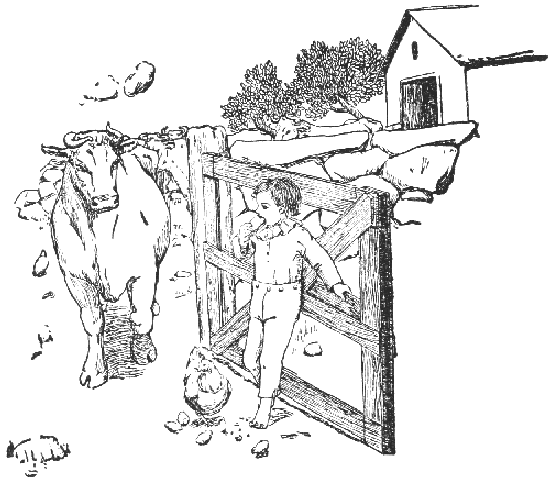
So the cows waited at the gate, and little John had come down-stairs and Aunt Deborah had given him a piece of johnny-cake, because breakfast wasn't ready and little boys are always hungry. Then little John came to the gate to the cow-yard, and opened the gate, and the cows hurried to go through the gate, the leader first, and the others following after. And they went along the little track and through the gate into the road, and along the road to the great enormous field. And there they stopped, for the bars were up and they had to wait for little John to come along and let them down, so that they could go through.
And little John came running along, eating his piece of johnny-cake, and kicking up the dirt with his bare feet, for in the summer-time he didn't wear any shoes or stockings. And he came to the gate and he let the bars down at one end, and the cows stepped over the bars carefully, the leader first, and went into the field. And little John put the bars up again, so that the cows couldn't get out, and he turned around and ran back to the farm-house to get his breakfast.
When the cows were all in the field, they began to eat the grass; and they walked slowly about, eating the grass, until they had had all they wanted. Then they went over to the corner of the field, where there was a stream of water running along, and each cow took a drink of water. In the middle of the field was a big tree with long branches and a great many leaves, so that under the tree it was shady and cool. By the time the cows had eaten all the grass they wanted, it was hot out in the sun, and they all walked over to the big tree and got in the cool shade.
Some of them lay down and some of them stood still, and they switched their tails about to keep the flies off, and they chewed their cuds. For a cow has two kinds of stomach. When she bites off the grass, she swallows it down quickly, and it goes into the first stomach; and after awhile, when she has eaten all the grass she wants, she goes and lies down, or stands still and some of the grass comes back into her mouth in a bunch and she chews it all up fine and swallows it again, so that it goes down into her real stomach. Then another bunch comes up and she chews that and swallows it, and so she does until all the grass is chewed up fine. That is what they call chewing the cud.
So the cows stayed in the shade of the big tree until they were hungry again, and then they walked about and ate some more of the grass and drank some more water out of the little stream. And by that time it was in the afternoon and almost time for little John to come to drive them home.
So they all stood looking at the gate and waiting for little John. And by and by little John came running along, and he let down the bars at one end, and he called "Co-o-ow! Co-o-ow!" and the cows all started hurrying along to the gate. And they stepped over the bars carefully, the leader first, and walked along the road, for they knew the way to go. And little John came running after.
When the cows came to the farm-house, they turned in at the gate and went up the little track to the cow-yard. And they went in at the gate of the cow-yard, and up the sloping place into the barn. And each cow knew where she ought to go, and she went there, and Uncle John fastened the chains around their necks; and little John shut the gate of the cow-yard and went into the house.
Then Uncle John put a measureful of meal in the manger in front of each cow, and he got his milking-stool and the milk pails and he milked all the cows. And while the cows were being milked, they ate the meal and chewed their cuds.
When the cows were all milked, Uncle John poured the milk through the strainer into the big cans and took it out to the spring-house to set it, so that the cream would come on it. But some of the milk he took into the house for their supper.
Then he shut the big doors of the barn and fastened them, and the cows lay down and went to sleep.
And that's all.
 NCE upon a time there
was a farm-house, and
it was painted white
and had green blinds;
and it stood not far
from the road. In the
fence was a wide gate to let the wagons
through to the barn. And the wagons,
going through, had made a little track
that led up past the kitchen door and
past the shed and past the barn and past
the orchard to the wheat-field.
NCE upon a time there
was a farm-house, and
it was painted white
and had green blinds;
and it stood not far
from the road. In the
fence was a wide gate to let the wagons
through to the barn. And the wagons,
going through, had made a little track
that led up past the kitchen door and
past the shed and past the barn and past
the orchard to the wheat-field.
All about were other fields. One of them was a great enormous field, and in this field was growing grass that would be made into hay.
One day, when the summer was nearly half over, Uncle John saw that the little tassels at the tops of the stems of the grass were getting yellow, and he knew that the grass was ripe enough to cut for hay; and the grass was as high as little John's head. So, very early the next morning, Uncle Solomon and Uncle John took their scythes and their whetstones and went over to the great enormous field, and two other men came to help. When the grass that these other men had was ready to cut, then Uncle Solomon and Uncle John would go and help them cut it.
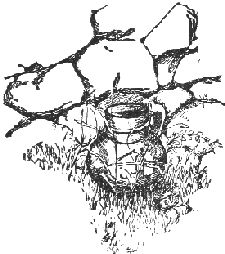
And they had a jug, and in it was water, with some molasses and a little vinegar mixed with it. This was for them to drink when they got very hot and thirsty, mowing, and they put it down by the stone wall, where it was cool.
Then the men all took their whetstones and sharpened their scythes, and Uncle Solomon started first, at the corner of the field, and he swung his scythe back and forth, and every time he swung the scythe it cut down some grass and made a noise, "Swish." And then he took a little step ahead and swung the scythe again, and he walked very slowly along, cutting the grass. And when Uncle Solomon had got a little way along, so that the next scythe wouldn't cut him, Uncle John began next to the place where Uncle Solomon had begun, and he swung his scythe and walked slowly along, cutting the grass. Then one of the other men began at the next place, when Uncle John had got a little way along, and then the last man. So all the men were walking slowly along, swinging their scythes together, and cutting the grass, and the grass fell down in four long rows. And they mowed this way all the morning, and cut down all the grass in the field.
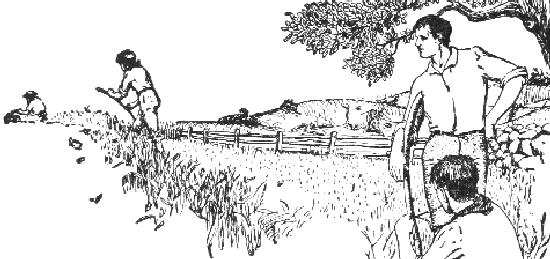
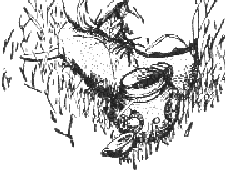
And just when they had finished, and all the grass was cut down, they heard the horn that Aunt Deborah was blowing. That meant that dinner was ready. They had a horn to blow for dinner because the men had to work in fields that were far from the house, where they couldn't hear a dinner-bell. But they could hear the horn. So the horn hung on a hook beside the kitchen door; and when dinner was ready, Aunt Deborah took the horn from the hook and blew it.
When the men heard the horn, they took their coats and their scythes and their whetstones and the jug, and they went back along the road to the farm-house and left the grass lying there, just as it fell down. And the sun shone on the grass and dried it, so that it was changing to hay.
Then, the next morning, Uncle Solomon and Uncle John took their pitchforks and went over to the field and spread the grass out evenly, so that it would dry better; and they left it until the afternoon.
In the afternoon, Uncle John and Uncle Solomon took two great wide wooden rakes, and little John took a little rake, and they went to the field. Then Uncle Solomon and Uncle John each held one of the great wide rakes so that it trailed behind, and they walked along and the rakes rolled the grass up into long rows. Then they walked along the other way, trailing the rakes, and the grass rolled up into piles, and little John raked after. They call the piles of hay haycocks, and they were as high as little John's head. Then they went away and left the hay there all night.
In the morning, when the sun had shone on the haycocks long enough to dry off the dew, Uncle John got out the old oxen. And they put their heads down, and he put the yoke over and the bows under, and he hooked the tongue of the hay-cart to the yoke. Then he put little John up in the cart and took the pitchforks, and gave little John his little rake. And the old oxen started walking slowly along, out into the road and along the road to the great enormous field, and in at the gate. And they walked along beside one of the haycocks, and there they stopped.
Then Uncle John lifted little John out of the cart, and Uncle Solomon and Uncle John both stuck their pitchforks into the haycock and lifted it right up and pitched it over the side of the cart, so that it fell into the cart. Then they went along to the next haycock and pitched that in the same way, and little John raked after, raking up the hay that had dropped from the pitchforks. So they went along to the other haycocks and pitched them into the cart, and when the hay was nearly up to the top of the side of the cart, Uncle John climbed in, and he made the hay even in the cart, with his fork. Uncle Solomon pitched the hay up into the cart, and Uncle John made it even in the cart, so it couldn't fall out, and they piled the hay up in the cart until it was a great enormous load, higher than the room. And little John raked after.
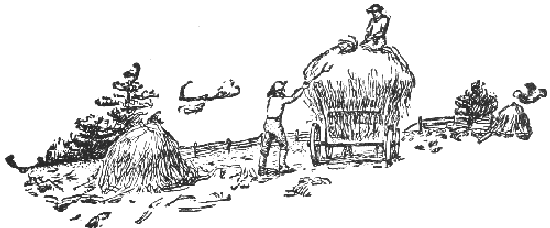
When they had made the load as high as they could, the old oxen started and turned around, and walked back through the gate and along the road to the farm house, and in at the gate and up the track past the kitchen door and past the shed, and in at the big door of the barn. And they went along in the open place in the barn and stopped in the middle, so that the load of hay was beside the floor of the loft where the hay was kept, and the top of the load was higher than the floor of the loft.
Then Uncle Solomon climbed up the ladder to the loft, and Uncle John pitched the hay from the cart to the loft. And Uncle Solomon took his fork and pitched the hay back against the wall and packed it tight, so that they could get more in when they brought it, and fill the loft as full as it would hold.
When all the hay was out of the cart, Uncle Solomon came down from the loft, and the oxen started walking along, out of the other big door and around the barn and back to the hay-field. Then they filled the cart again, the same way that they did the first time, and put that hay in the barn. And they had to go back three times after the first time before they had all the hay that was in the field. And when it was all in the barn, there was hay enough for the horses and the oxen and the cows to eat all winter.
Then the old oxen walked out through the other door of the barn, and around the barn to the shed. And Uncle John unhooked the tongue of the cart and put the cart in the shed, and he took off the yoke and the oxen went into the barn and went to sleep.
And that's all.
 NCE upon a time there
was a farm-house, and
it was painted white
and had green blinds;
and it stood not far
from the road. In the
fence was a wide gate to let the wagons
through to the barn. And the wagons,
going through, had made a track that led
up past the kitchen door and past the
shed and past the barn and past the orchard
to the wheat-field.
NCE upon a time there
was a farm-house, and
it was painted white
and had green blinds;
and it stood not far
from the road. In the
fence was a wide gate to let the wagons
through to the barn. And the wagons,
going through, had made a track that led
up past the kitchen door and past the
shed and past the barn and past the orchard
to the wheat-field.
In the kitchen there wasn't any stove, because they didn't have stoves then, but there was a great enormous fireplace, so big that great long sticks of wood could be put in it to burn. And Uncle John or Uncle Solomon had to cut the wood that was to be burned in the fireplace, and pile it up in a great pile near the kitchen door.
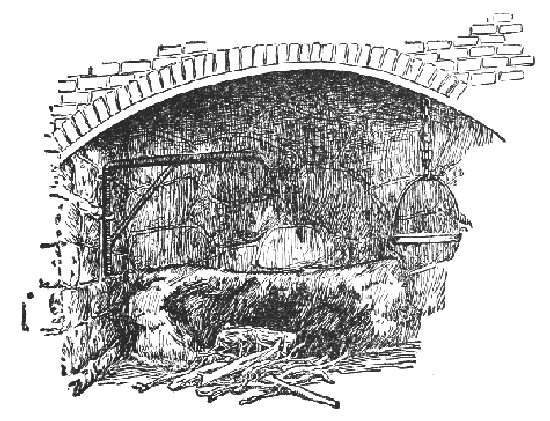
In the fireplace was a long iron stick that went along near the top, and at the side of the fireplace it bent down like an elbow and went into some hinges that were in the wall of the fireplace. And at the end of this long iron stick was a hook, so that a kettle would hang on it over the fire. This iron stick they call a crane; and it would swing out on the hinges, away from the fire, so that they could hang something on without burning their hands, and then they could swing it back again.
And every night, before she went to bed, Aunt Deborah took the shovel and put ashes all over the fire, so that it wouldn't blaze and burn the wood all up, but wouldn't go out, either. For there wasn't any furnace, and if the fire went out, the house would get very cold, and there weren't any matches then, so that it was hard to light the fire.
At that farm-house were a great many chickens, and in the summer-time they liked to fly up into the trees, and sit on the branches to sleep. And in the morning, as soon as it began to get light, the old rooster would wake up and flap his wings and crow very loud. So, one morning, the old rooster crowed very early and waked Uncle John and Aunt Deborah, and Uncle Solomon and Aunt Phyllis.
And they all got up and put on their clothes and went down-stairs. Uncle Solomon and Uncle John went to the barn to look after the horses and the cows and the oxen, and Aunt Deborah and Aunt Phyllis began to fix the fire and get breakfast ready.
Aunt Phyllis went to the spring-house for the milk and the butter, and to the buttery for some other things. Then she went to the hen-house to find some eggs.
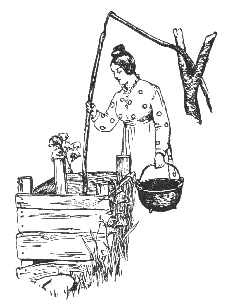
Aunt Deborah raked all the ashes off the fire and put on some sticks of wood that Uncle John had brought in, and then she took the blower and blew the fire with it until it began to blaze. Then she took the iron kettle and filled it with water at the well, and she pulled the crane out away from the fire, with an iron hook, and hung the kettle on the hook of the crane, and swung it back over the fire. And the fire blazed, and the water in the kettle got hot, and after a while it began to boil.
While the water in the kettle was getting hot, Aunt Deborah took some corn-meal and some flour and some salt and some sugar, and mixed them together in a big yellow bowl, and she mixed in some soda and some cream-o'-tartar. They are fine white powders that would make the johnny-cake light and nice when it was baked; for she was making johnny-cake. Then she took the milk that Aunt Phyllis had brought from the spring-house, and she poured some of it into the bowl and stirred it all in. And when she had poured in all the milk that she wanted, she took some of the eggs that Aunt Phyllis had brought, and she broke the shells and let the inside of the eggs drop into a littler bowl, and then she beat them all up together until they were all foamy. Then she poured them into the big yellow bowl and stirred them all in. When all the things were stirred up together, Aunt Deborah took a pan that had a cover, and she put butter all over the pan, and poured in the things from the yellow bowl. Then she put on the cover, and she took a kind of rake and she raked some of the blazing fire away, and with a long iron fork she put the pan down on the hot coals. Then she raked the fire on top of the pan again and left it.
When the johnny-cake was in the fire, getting baked, Aunt Deborah got some tea out of the jar that they called a caddy, and she put it in the teapot. Then she pulled the crane away from the fire, with the hook, and she poured some boiling water in on the tea and set the teapot down in front of the fire. Then she put some eggs in the kettle and swung it back over the fire.
While Aunt Deborah was making the johnny-cake and the tea, Aunt Phyllis had put the plates on the table, and the mugs, and the cups and saucers, and the knives and forks, and all the other things, and she had put some butter on the table, on a plate, and some milk in a white pitcher. Then she went to the buttery and took down a ham that hung on a hook, and she cut some thin slices and put them on a plate and put that plate on the table. And by that time the johnny-cake was done and the eggs, and the tea. And Aunt Deborah swung the crane off the fire and took the eggs out with a ladle that had little holes in it for the water to go through. Then she poured cold water on the eggs, so that they wouldn't cook any more, and she put them in a bowl and put them on the table. Then she raked the fire off the top of the pan, and took the pan out with the long iron fork. And she took the cover off, and the johnny-cake was nice and brown, and just right and smoking hot. And she cut it into little squares and put it in a dish, and Aunt Phyllis put all the rest of the things on the table while Aunt Deborah went to the door and took down the horn and blew it.
Then Uncle Solomon and Uncle John came in from the barn, and little Charles and little John came in from driving the cows, and little Sam came down-stairs. And they all sat down at the table and ate their breakfast, and it was very nice.
And that's all.
 NCE upon a time there
was a farm-house, and
it was painted white
and had green blinds;
and it stood not far
from the road. In the
fence was a wide gate to let the wagons
through to the barn. And the wagons,
going through, had made a little track that
led up past the kitchen door and past
the shed and past the barn and past the
orchard to the wheat-field.
NCE upon a time there
was a farm-house, and
it was painted white
and had green blinds;
and it stood not far
from the road. In the
fence was a wide gate to let the wagons
through to the barn. And the wagons,
going through, had made a little track that
led up past the kitchen door and past
the shed and past the barn and past the
orchard to the wheat-field.
One morning the old rooster had crowed very early, and Uncle Solomon and Uncle John and Aunt Phyllis and Aunt Deborah had come down-stairs and done their work. It was Saturday morning, and that was baking day; so, when they had all finished breakfast, and Aunt Deborah and Aunt Phyllis had cleared up the things and washed the dishes, they got ready for the baking.
The chimney was a great enormous chimney that went all across the end of the kitchen. And beside the big fireplace was an iron door that opened into the oven. For the oven was a big hole in the chimney, beside the fireplace; and right in the middle of the chimney, behind the fireplace, was a great big hole, as big as a closet, and at the back was a little door that was just big enough for people to go in. In this closet in the chimney they used to build a fire sometimes, and hang hams and fish over it in the smoke.
When they were ready to begin, Aunt Deborah opened the door to the oven, and she took some wood that Uncle John had brought in, and she built a fire right in the oven. Then she took up some coals from the fireplace and lighted the fire in the oven and shut the door. And the fire burned and the oven got hot. And once in awhile Aunt Deborah opened the door and put in some more wood.
Then, while the fire was burning in the oven and getting the oven hot, Aunt Deborah and Aunt Phyllis took flour and butter and lard and water, and they mixed them together just the right way, and made some dough. And they rolled the dough out thin, with a long wooden roller, and they folded it over and rolled it out again, and did that over and over until they thought it was right. Then they spread the thin dough out on the bottom of some plates that were middle-sized deep.
And Aunt Deborah had some apples all ready, with the skin cut off and the cores cut out, and the nice part of the apples cut up into slices. And some of the apples she had stewed in water until they were all soft, and some she hadn't.
First she put some of the stewed apples in the plates on top of the thin dough, and put in a little sugar and some cinnamon and some nutmeg on top of some; and on some she didn't put any cinnamon or any nutmeg. Then she laid another thin piece of dough over the top of the apples, and she made little marks with a fork all around the edge, and she cut holes in the top with a knife.
Then, in other plates she put the apples that were not stewed, and a lot of sugar, and thin dough on top, the same way. Those were apple pies, and they were three kinds.
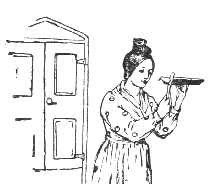

Then Aunt Deborah made some squash pies, and put in on the dough that was on the bottom of the plates some of the inside of squashes that she had cooked over the fire. The very inside of squashes is soft and full of seeds, and that part isn't good to eat; but just next to the seeds is the part that is good. And spices and a lot of things were mixed with the squash to make it taste better. There wasn't any thin dough put over the top of the squash pies, but just a thin strip around the edge. And there were other kinds of pies besides the apple and the squash, and when they were made, there were so many that they covered the tops of both the tables, for Uncle Solomon and Uncle John liked pies.
Then Aunt Deborah thought the oven was hot enough, and she opened the door of the oven, and with a long rake she pulled the fire out into a big pan and put it into the fireplace. Then she put into the oven all the pies it would hold, and she shut the door; and the pies were baking in the oven, it was so hot, though there wasn't any fire in it. And when those pies had been in the oven for awhile, they were all done, and Aunt Deborah pulled them out with a kind of shovel and set them down in front of the fire, and she put other pies in; and so she did until all the pies were baked.
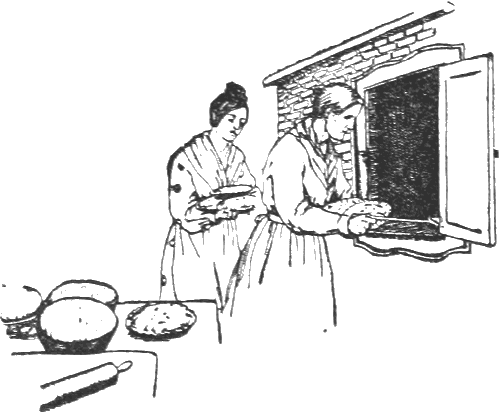
Then she put coals in the oven again, and a little wood, to get the oven hotter, for it had cooled, baking so many pies.
When she first came down that morning, Aunt Deborah had mixed some bread, and had set it in a big pan near the fire, to rise; and now it had risen enough, and she took it out of the big pan. And while the oven was getting hot again, she put the bread on a smooth board and rolled it around and pushed it with her hands. That is what they call kneading.
Then she took some square pans that were deep, and she put some of the bread in each pan and set them down by the fire again. And pretty soon the oven was hot enough, and the fire was raked out, and the bread was put in. By that time it was time to get dinner ready, and Aunt Deborah left the bread in the oven while she got dinner. For the oven was getting cooler all the time, and the bread would not get burned.
So, when the bread was done, Aunt Deborah took it out and wrapped it in a cloth until it was cool. And Aunt Phyllis put all the pies in the buttery. Then they had enough pies and enough bread to last them all a whole week, and they would not bake any more until the next Saturday.
And that's all.
 NCE upon a time there
was a farm-house, and
it was painted white
and had green blinds;
and it stood not far
from the road. In the
fence was a wide gate to let the wagons
through to the barn. And the wagons,
going through, had made a track that
led up past the kitchen door and past
the shed and past the barn and past the
orchard to the wheat-field.
NCE upon a time there
was a farm-house, and
it was painted white
and had green blinds;
and it stood not far
from the road. In the
fence was a wide gate to let the wagons
through to the barn. And the wagons,
going through, had made a track that
led up past the kitchen door and past
the shed and past the barn and past the
orchard to the wheat-field.
In that farm-house lived Uncle Solomon and Uncle John, and little John and little Charles and their mother, Aunt Deborah, and little Sam and his mother, Aunt Phyllis.
One day in summer it was very hot. Little Charles was about nine years old, and little John was about seven, and little Charles said to little John: "John, let's go in swimming."
And little John said: "All right."
So they went very quietly away from the kitchen door, where they were playing, and went toward the barn, as though they were going to look for eggs. But they sneaked around the barn and down close to the house on the other side, where Aunt Deborah wouldn't see them, and over the fence into the road. And they went along the road until they came to the field that they used to go through to get water from the river. Then they turned into that field and went down to the river, and along the bank of the river until they came to a great big tree that grew close by the edge of the river, at the end of a stone wall.
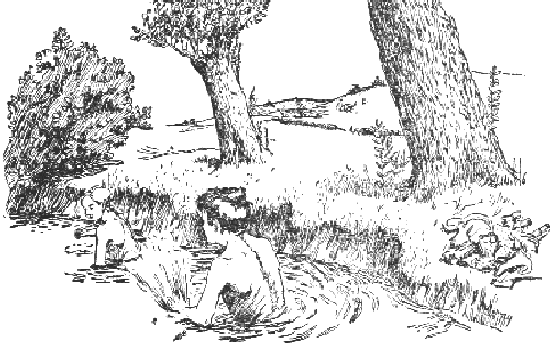
When they came to that big tree, they stopped and took off all their clothes and went into the water. And they stayed in the water a long time and swam around and chased each other, and they ran along in the water where it wasn't very deep, and splashed and had a fine time. And when they had been in long enough and were all cool, they went back to the place where they had left their clothes, and they took their shirts and got themselves dry with their shirts as well as they could. Then they spread their shirts out in the sunshine to dry, and they ran about on the bank. And when their shirts were dry, they put their clothes on. Then they went back along the road and over the fence and around the barn, the way they had come, and began to play near the shed as though they hadn't been away at all.
Pretty soon Aunt Deborah came to the kitchen door and she called to little Charles.
"Charles, I want you to get me some eggs."
And when Charles turned around to go, Aunt Deborah looked at him very hard, and she called: "Charles, come here to me." But Charles didn't want to come very near, so he came only a little way.
And Aunt Deborah said: "Charles, I want you to come right here to me."
So Charles came slowly beside his mother, and she took off his hat and looked at his hair. His hair was a little wet, for he couldn't get it quite dry with his shirt.
And Aunt Deborah said: "Charles, you've been in swimming."
And Charles dug up the dirt with his bare feet and said, "Yes'm." For little Charles and little John never said things that were not true, although they sometimes did things they ought not to do.
Then Aunt Deborah said: "Charles, if you do that again I'll tell your father."
And Charles said, "Yes'm." Then he ran away quickly to find the eggs.
Then Aunt Deborah said: "John, come here to me."
So little John came beside his mother, and she took off his hat and saw that his hair was wet.
And she said: "John, you've been swimming, too." And little John looked at his mother and grinned and said, "Yes'm."
And Aunt Deborah said, "You mustn't do that, John. You're too little. Don't do it again, and I'll ask Uncle Solomon to take you and Charles in his boat." So little John ran off after little Charles.
The next morning Uncle Solomon called to all the little boys: "Who wants to go out in the boat with me?"
And little Charles and little John and little Sam all said at the same time, "I do."
So Uncle Solomon said, "Come on, boys."
Then he walked along the track and into the road and along the road, and the little boys ran ahead; for they knew where he was going. And by and by they came to the pond. It was a great big pond, and Uncle Solomon's boat was on the bank under some trees. Uncle Solomon had built that boat himself, for he had been a sailor, and knew all about boats. So he pushed the boat off into the water, and the little boys all got in and sat still. For Uncle Solomon wouldn't let them jump around in the boat because that might tip it over.
So Uncle Solomon rowed the little boys over to a nice place where it was shady, and where the water was not very deep; and he rowed cross-handed, because he thought that was easier. When they had got to the place, the little boys all took off their clothes, and Uncle Solomon took up each boy and threw him over into the water. They were not afraid, because he had taught them how to swim, and he was right there, to see that nothing happened to harm them. And they swam around and had a fine time.
And when Uncle Solomon thought they had been in the water long enough, he made them swim near the boat, and he reached over and pulled them into the boat, one at a time. Then they dried themselves with a towel he had brought, and they put on their clothes, and Uncle Solomon rowed the boat back to the place where he kept it.
Then the little boys got out and he pulled the boat up on the shore, and they all went back along the road to the farm-house. And they went in at the wide gate and up to the kitchen door. And there was Aunt Deborah, with four pieces of gingerbread. One piece she gave to little Charles and one to little John and one to little Sam, and the biggest piece of all she gave to Uncle Solomon.
And they all ate their gingerbread, and thought it was very good indeed.
And that's all.
 NCE upon a time there
was a farm-house, and
it was painted white
and had green blinds;
and it stood not far
from the road. In the
fence was a wide gate to let the wagons
through to the barn. And the wagons,
going through, had made a track that
led up past the kitchen door and past
the shed and past the barn and past the
orchard to the wheat-field.
NCE upon a time there
was a farm-house, and
it was painted white
and had green blinds;
and it stood not far
from the road. In the
fence was a wide gate to let the wagons
through to the barn. And the wagons,
going through, had made a track that
led up past the kitchen door and past
the shed and past the barn and past the
orchard to the wheat-field.
Behind the barn was the hen-house, and inside the hen-house there were long poles that went all the way across, for the hens to sit on to sleep. Those poles they call roosts. In winter the hens all sleep on the roosts in the hen-house, because it is warmer there; but in the summer they like to get up in the trees and sleep out-of-doors.
Along the side of the hen-house were some boxes with hay in them, and a board along the top. These were the nests, and in each nest was a pretend egg, made of china. The hens would see the pretend egg and think it was real, and they would lay the real eggs in the nests. For they like to lay eggs in places where eggs are already.
There was a little door, low down, for the hens to go through, and outside was a yard, with a fence around made of strips of wood. In this fence was a door that was kept shut in winter, but was open in summer so that the hens and chickens could go out and eat the bugs and worms. Bugs and worms sometimes eat the growing things that the farmers have planted, so the farmers like to have the chickens eat the bugs and worms. And in the side of the hen-house was a big door for people to go through.
When the summer was beginning, there were a good many hens and some chickens that were half grown up, and a very old rooster, and some that were not so old. Sometimes the roosters would fight, but they didn't fight very hard, for they were not the kind that fight hard.
All the roosters and the hens and the chickens that were half grown up flew up into the trees when it was beginning to be dark, and they sat on the branches in long rows, and put their heads under their wings and went to sleep. The very old rooster and most of the hens roosted in the apple-trees in the orchard, but some of the hens roosted in other trees.
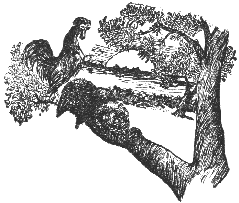
And in the middle of the night the old rooster waked a little and crowed, but it wasn't a very loud crow. But when it began to be light in the morning, the old rooster waked and flapped his wings and crowed very loud. And that waked the other roosters and they flapped their wings and crowed, and the hens waked, and all the roosters and the hens flapped their wings and flew down to the ground, and began to look about for their breakfast.
Some of the hens stayed in the orchard and looked about on the ground and scratched up the dirt and picked up the bugs and worms that they found. Some of them went over to the cow-yard and flew over the fence and scratched around there, and they drank water out of the big tub in the corner. And some of the hens went to the kitchen door to see what things Aunt Deborah had thrown down there for them to eat. The chickens that were half grown up went over to the fields where the potatoes and the beans and the peas were growing, and they ran about among the vines and picked the bugs and worms off the vines.
After awhile, when all the hens and chickens had finished their breakfasts, some of the hens went into the hen-house to lay eggs.
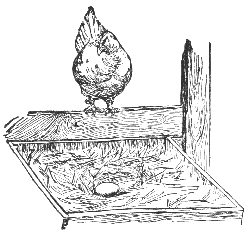
Each of these hens laid one egg in one of the nests, and when she had laid the egg, she came out of the hen-house and cackled and made a great noise. For that is the way hens do. But there were two of the hens that did not like to lay eggs in the hen-house.
One of these hens walked along the little road and across the wheat-field into the maple-sugar woods. She had made a nest there, out of dried grass and leaves, and it was hidden away under some bushes, where nobody could find it. That hen laid an egg in that nest every day, until she had laid nine. Then she sat on the eggs and kept them warm, and she came over to the farm-house every day to get something to eat and then she went back to her nest again. And when she had sat on those eggs for three weeks, the little chickens came out of the shells and ran about. And then she walked over to the farm-house and the little chickens ran along with her.
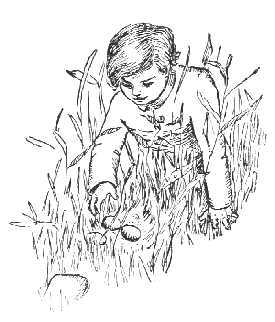
The other hen that wouldn't lay eggs in the hen-house made a nest in the wheat-field; but little John found that nest and took the eggs away, so she didn't have any chickens.
When the hens had laid their eggs, they went out into the road and sat down in the dust and scratched the dust up all over themselves, for they liked the warm dust in among their feathers. And they stayed there until they were hungry again. Then they scratched around in the dirt, and ate some more bugs and worms, and the things that Aunt Deborah threw out for them to eat. And so they did until it began to get dark.
Then they all walked along to the orchard or to some other trees, and they stood under the trees, and looked up and gave queer little jumps and flapped their wings, and they flew up into the trees and sat on the branches. And they went along the branches sideways until they had found the places they liked. Then they squatted down and put their heads under their wings and went to sleep.
And that's all.
 NCE upon a time there
was a farm-house, and
it was painted white
and had green blinds;
and it stood not far
from the road. This
farm was Uncle Solomon's. But before
he had the farm, he was a sailor, and
he sailed in great ships, over the great
enormous ocean. A great many ships
used to sail from Boston, over the big
ocean, carrying different things to far
countries, and one of these ships was the
brig Industry. Uncle Solomon was the
captain of the brig Industry, but that was
when he was a young man, and a long
time before he had the farm.
NCE upon a time there
was a farm-house, and
it was painted white
and had green blinds;
and it stood not far
from the road. This
farm was Uncle Solomon's. But before
he had the farm, he was a sailor, and
he sailed in great ships, over the great
enormous ocean. A great many ships
used to sail from Boston, over the big
ocean, carrying different things to far
countries, and one of these ships was the
brig Industry. Uncle Solomon was the
captain of the brig Industry, but that was
when he was a young man, and a long
time before he had the farm.
One day the brig Industry was lying beside the wharf at Boston, and she was tied to the wharf with great ropes. And all the things had been put in the ship, the things they were to sell in the far country where they were going, and the things to eat, and the water they would drink. For the ocean water is salt and bitter, so that people can't drink it, and they had to carry all the water that they would need to drink and almost all the things they would need to eat. The water was in big hogsheads, down near the bottom of the ship. The sailors were all on the ship, and everything was all ready to start. Then Captain Solomon walked down the wharf, and he got on the ship, and the great ropes were untied, and the sailors hoisted the sails, and the ship sailed away from the wharf. She sailed down the harbour and past the islands and out into the great ocean.
So the wind kept blowing, and the Industry kept sailing along over the ocean for a great many days. She sailed along, through parts of the ocean where it is always hot and where it rains a great deal, and past the country where the monkeys live, and around the end of that country. And after awhile Captain Solomon saw some land, and he knew it was an island where no people lived, but where beautiful clear water ran out of a crack in the rock. So he made the ship go near that island, and then the sailors fixed the sails so that the ship wouldn't go ahead. And the sailors let down one of the rowboats into the water. For every big ship has some rowboats that are hung up over the deck. And they took all the hogsheads of water and emptied out what water was left. Then they put in the bungs and tied all the hogsheads together with ropes that went between them, and they threw them over the side of the ship into the water. Then the sailors in the rowboat caught the end of the rope and rowed, and they went to the island, dragging the hogsheads that floated on the top of the water. And they filled the hogsheads with nice fresh water that came out of the rock, and then they rowed back to the ship, dragging the hogsheads.
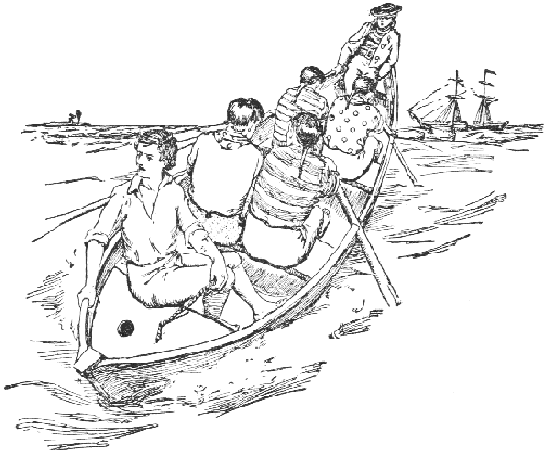
And they were hoisted up into the ship, and the rowboat was hoisted up, and the sailors fixed the sails again so that the ship would sail ahead.
So they sailed along for a great many days, and at last they came to the far country. That country is called India. And the Industry sailed into a wide river, and the sailors took down the sails and let down the great anchor to the bottom of the river. For the water by the shore was not deep enough for the ship to go there, so they had to keep the ship in the middle of the river. On the shore was a city, and a lot of men came out from the shore in little rowboats and took the things out of the Industry and carried them to the city. And the boats were so little, and there were so many things, they had to go back and forth a great many times.
When the things were all taken out of the ship, Captain Solomon had his rowboat let down into the water, and he got in, and two sailors rowed him to the land. Then he went to the man who had bought all the things he had brought, and the man paid Captain Solomon the money for the things. Then Captain Solomon started to look about to see what he could buy to take back to Boston.
First he bought a lot of tea, and a lot of spices, like cinnamon and cloves and nutmegs, and a lot of china dishes that had houses and trees and birds painted on them in blue. Then he bought a lot of pretty tables and such things that were made of teak-wood and ebony and ivory. And he bought a lot of little images that were carved out of ivory, and some trays that were shiny black, with birds and flowers painted on them in red and silver and gold. Then he bought a great many logs of teak-wood to carry back to Boston, to make into chairs and mantels and doors for the inside of houses. And when all these things were carried to the ship and put in, Captain Solomon had some money left, and he looked about to see what he could buy that was very nice.
In India they have cloth that is made of the hair of goats, and shawls that are made of the hair of camels. The people made these things and brought them to the city to sell. The cloth was very nice and the shawls were very fine and beautiful.
So Captain Solomon went to the place where they had the cloth of goat's hair and the camel's-hair shawls, and he bought a great many shawls and some of the cloth. Some of the shawls were white, with a pattern of curly shapes in the middle, in red and blue and yellow, and some had a border of the same kind all around the edge. Some were red, with a pattern all over them of blue and brown and yellow and white. And besides the shawls, there were narrow pieces made of camel's hair, that were meant to be worn around ladies' necks. And they were all very beautiful.
So Captain Solomon had all the shawls and the pieces of cloth put in two great chests made of cedar, and he had the chests carried on the ship and put in his cabin. His cabin was the room where he did all his work, looking at the charts and maps, to see where the ship was, and writing down in a book what happened every day. The beautiful shawls would be taken care of in his cabin better than in the bottom of the ship, with the teak-wood and the other things.
When Captain Solomon had bought the shawls and got them put on the ship, he bought a lot of things for the sailors to eat while the ship was sailing back to Boston. There were flour and meal and very hard crackers and salt and sugar and fine hominy and peas and beans and a lot of other things, and great hogsheads of meat that was in salt water. And there was a cow that they kept in a kind of pen on the deck of the ship, and four sheep and a lot of chickens. So they could have milk and eggs, and sometimes roast chicken for dinner, or roast mutton. Then they filled all the water barrels with fresh water, and the sailors pulled up the great anchor and hoisted the sails.
So the Industry sailed out of the river and into the big ocean, and they sailed away for a great many days. And when they came to the island where the nice water ran out of the rock, Captain Solomon had all the water barrels filled with fresh water again. Then they sailed along, around the end of the country where the monkeys lived, and over another big ocean. And after a long time they came to Boston, and the Industry sailed in past the islands and into the harbour, and up to the wharf. And the sailors took down the sails and fastened the ship to the wharf with great ropes.
Then Captain Solomon went on shore and got a big wagon. The horses dragged the wagon down on the wharf, and the men took the two chests out of the cabin and put them on the wagon. Then Captain Solomon got on the wagon with the men, and they drove the horses through the streets until they came to the place where the men stayed that owned the Industry. That place they call an office.
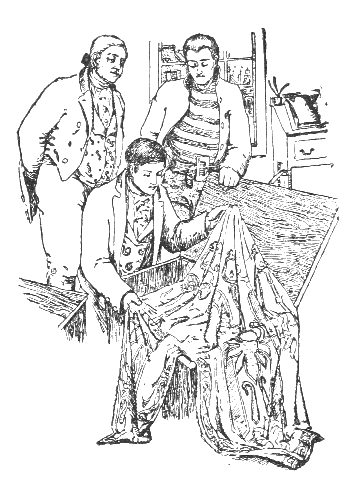
So Captain Solomon got down from the wagon, and the men took the chests and carried them into the office. In the office were Captain Jonathan and Captain Jacob. They had been sailors, too, and they owned the Industry. And Captain Solomon opened the chests and showed the cloth and the shawls to Captain Jonathan and Captain Jacob, and they thought the cloth and the shawls were very beautiful. And while Captain Jonathan was looking at the shawls he found one that was white, with a pattern in the middle of red and yellow and brown and blue. He thought that shawl was the prettiest shawl he had ever seen. So he said: "Jacob, I am going to give this shawl to my daughter Lois."
And Captain Jacob said, "All right." For Captain Jonathan's daughter Lois was Captain Jacob's wife.
So Captain Jonathan gave the shawl to his daughter Lois. And after a great many years she gave the shawl to her daughter Lois. And after a great many years more, when that Lois was an old lady, she gave the shawl to her niece, who was named Lois. And when that Lois was an old lady she used to wear the shawl almost all the time. But one day she forgot and hung the shawl over the balusters near the door just when the cook was going away. And the cook saw the shawl and took it away and never brought it back.
And that's all.
 NCE upon a time there
was a farm-house, and
it was painted white
and had green blinds;
and it stood not far
from the road. And
in the fence was a wide gate to let the
wagons through to the barn. The farm
wasn't Uncle Solomon's then, but it belonged
to the man that had built the
farm-house, and that man had built the
barn first and then the house. And he
had cut down the trees and made the
fields smooth and nice where the different
things were to grow. And when he had
lived there a good many years, he was
tired of being there, and he wanted to go
somewhere else.
NCE upon a time there
was a farm-house, and
it was painted white
and had green blinds;
and it stood not far
from the road. And
in the fence was a wide gate to let the
wagons through to the barn. The farm
wasn't Uncle Solomon's then, but it belonged
to the man that had built the
farm-house, and that man had built the
barn first and then the house. And he
had cut down the trees and made the
fields smooth and nice where the different
things were to grow. And when he had
lived there a good many years, he was
tired of being there, and he wanted to go
somewhere else.
Captain Solomon had sailed on the great ocean a great many years, and he was tired of being a sailor, and thought he would like to have a farm; and besides, he was afraid that if he kept on being a sailor, his little boys would want to be sailors, too, and he didn't want them to be. There were three boys, Uncle John and his two brothers; and when they got big enough, Uncle John's brothers ran away and were sailors. For they didn't like to be on a farm. But Uncle John stayed on the farm after Uncle Solomon bought it.
So one day Captain Solomon came to the farm and he found the man that had got it all ready and had built the house. And the man showed Captain Solomon all the fields where the things were growing, and the orchard and the maple-sugar woods and the barn and the house. And Captain Solomon liked the farm. So he paid the man some money, and the man gave the farm to Uncle Solomon. For after he had bought the farm, the people all called Captain Solomon Uncle Solomon. Then the man took all his beds and chairs and tables and the other things from the house, and he moved them away to another place.
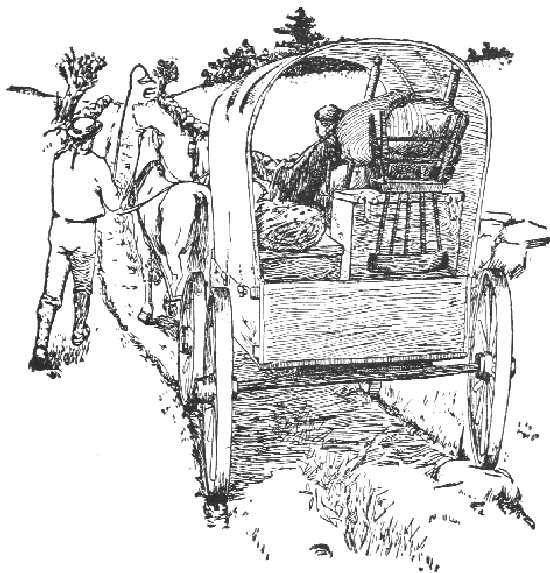
Then Uncle Solomon put all his things in great wagons, and it took a long time to move them to the farm, for Uncle Solomon had lived in Wellfleet, a town that is on the shore of the great ocean, and the farm was a long way from that town, and it was not on the shore of the ocean. They didn't have railroads then, and all the things had to be dragged in the wagons. But at last the wagons came to the farm, and Uncle Solomon took all the things out of the wagons and put them in the house. He put the wagons in the shed and the horses in the barn. That was a very long time ago, more than one hundred years.
When all the things were put in the house, Uncle Solomon bought some cows and the things he needed to do farm work with. Then he began to do all the things that have to be done on a farm, the things that the other stories tell about.
And that's all.
 NCE upon a time there
was a farm-house, and
it was painted white
and had green blinds;
and it stood not far
from the road. In the
fence was a wide gate to let the wagons
through to the barn. And the wagons,
going through, had made a track that led
up past the kitchen door and past the
shed and past the barn and past the
orchard to the wheat-field.
NCE upon a time there
was a farm-house, and
it was painted white
and had green blinds;
and it stood not far
from the road. In the
fence was a wide gate to let the wagons
through to the barn. And the wagons,
going through, had made a track that led
up past the kitchen door and past the
shed and past the barn and past the
orchard to the wheat-field.
In the morning, when Uncle John had milked all the cows, he took all the milk, in the big pails, to the milk-room that was in the corner of the barn, and he poured it through a cloth into some cans. Then he carried the pails to the kitchen door, and Aunt Deborah washed them out with cold water. Then she poured some very hot water into them and rinsed them out, and set them in the sunshine. And Uncle John went back to the milk-room and took the cans of milk and carried them out to the spring-house.
The spring-house was a little low house that was in the orchard, and a stream of water ran right through the middle of it. It was the same stream of water that ran on through the big field where the cows went to eat the grass, and then it ran on, under the road and through another field and into the river. They didn't have ice then, in the summer time, but the water of the little stream was cool, and they used that to keep the milk and the butter from getting too hot. They had made a trench for the water to run through, and in the bottom of the trench they had put great flat stones, so that the water ran over the stones. And on top of the stones the water wasn't deep at all.
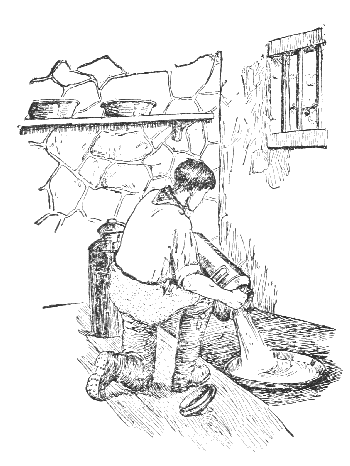
So Uncle John took the milk to the spring-house and poured it into big flat pans, and set the pans in the water on the flat stones, so that the water would keep the milk cool while the cream came to the top. The cream is the yellow, fat part of milk, and when the milk stands still, the cream comes to the top.
Every time Uncle John had finished milking the cows, he took the milk to the spring-house and put it in flat pans and left the pans in the cool water. And when the milk had stood so for as long as all day or all night, Aunt Deborah went out to the spring-house and took a kind of big spoon and skimmed the cream off the top of the milk, and put the cream into a stone jar. And she left the cream in the jar for two or three days until it was just right to make into butter.
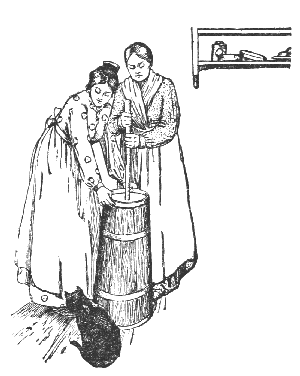
When the cream in the jar was just right, Aunt Deborah and Aunt Phyllis took it to the buttery and put it in the churn, a kind of box that had a long handle. And on the end of the handle was a big piece of wood with holes all through it. Then Aunt Phyllis took hold of the long handle and made it go up and down, and Aunt Deborah held on to the churn, so that it wouldn't tip over. And when Aunt Phyllis was tired, Aunt Deborah made the handle go up and down, and Aunt Phyllis held on to the churn. And the cream splashed all about, and at last it began to turn into butter, in little lumps.
When it was done enough, Aunt Deborah poured off the watery stuff that they called buttermilk, and she washed the butter with water, and she put in a lot of salt. The buttermilk she saved, because sometimes people like to drink it. Then she took the butter that was all in little lumps, and she worked it together, so that the water came out of it, and it was all in big lumps. And she worked that all together until it was worked enough, and was in one big lump.
Then she got a little mould, a kind of cup with a cover. And in the inside of the cover was a picture, cut into the wood, of an ear of corn and some marks all about. Then Aunt Deborah put some of the butter into the mould, and she put the cover over, and pushed hard, and the butter was squeezed into a little round cake, with the picture of the ear of corn on the top. Then she took out that piece and put in some more, and she made a little cake of that. And so she did with all the butter, until it was all in little cakes; and those cakes of butter they call pats.
When all the butter was made into pats, Aunt Deborah put the pats into a great round wooden box and carried the box out to the spring-house to get cold, and keep until it was wanted. Every week she made enough butter to fill the big round box. That was enough for them to eat, and some to take to market besides.
And that's all.
 NCE upon a time there
was a farm-house, and
it was painted white
and had green blinds;
and it stood not far
from the road. In the
fence was a wide gate to let the wagons
through to the barn. And the wagons,
going through, had made a track that led
up past the kitchen door and past the
shed and past the barn and past the
orchard to the wheat-field.
NCE upon a time there
was a farm-house, and
it was painted white
and had green blinds;
and it stood not far
from the road. In the
fence was a wide gate to let the wagons
through to the barn. And the wagons,
going through, had made a track that led
up past the kitchen door and past the
shed and past the barn and past the
orchard to the wheat-field.
All about were other fields where different things grew. There were squashes and turnips and melons and corn and oats and potatoes and cabbages and onions and peas and beans. Some of the bean plants grew like little short trees, but the others wanted to climb on something. So Uncle John had to get some bean-poles for the bean plants to climb up. So, one morning, when summer was just beginning, the bean plants had come up through the ground, and were tall enough to begin to climb.
Uncle John took his axe and a big sharp knife and he got out the old oxen. They put their heads down and he put the yoke over and the bows under, and hooked the tongue of the cart to the yoke. Then he said "Gee up there;" and the old oxen started walking slowly along, past the barn and past the orchard to the wheat-field, and little John came after.
And Uncle John took down the bars, and the oxen went through the wheat-field, and he took down the bars at the other side of the field, and they walked through into the maple-sugar woods. Then they went along the road in the woods past the little maple-sugar house, and they kept on until they came to a place where there weren't any big trees, but there were a great many little slim trees very close together. The little slim trees were about as big as little John's wrist at the bottom, and they were about twice as tall as Uncle John.
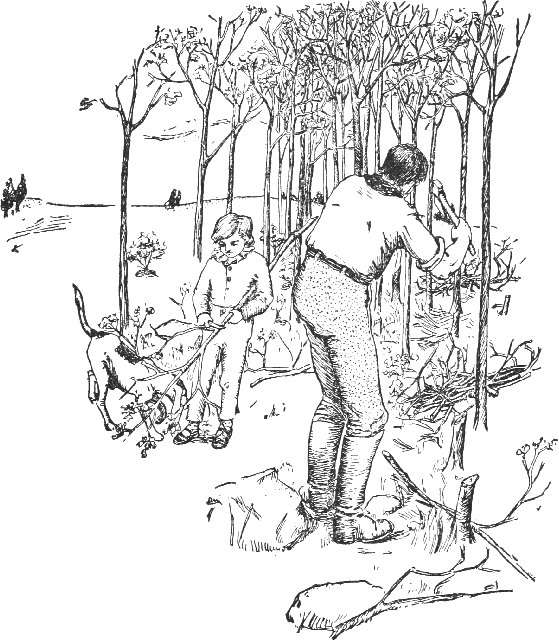
Then Uncle John stopped the oxen, and he took his axe and cut down a great many of the little slim trees. They were so little that he cut down each tree with one whack of the axe. And when the trees were cut down, as many as he wanted, he took the big sharp knife and he cut off all the branches of each tree. The trees grew so close together that there weren't many branches, and what there were, were very small. Then Uncle John put all the branches in a pile away from the trees, and he piled the trees all on the cart. The trees, after the branches were cut off, were straight and almost smooth. At the bottom they were about as big as little John's wrist, and at the top they were only as big as his thumb. These smooth trees without any branches they called poles.
Then Uncle John said, "Gee up there," and the oxen started and turned around, and walked slowly along, through the maple-sugar woods, and through the wheat-field, and Uncle John put up the bars after they had gone through. Then they walked along past the orchard and past the barn and past the shed and past the kitchen door, and through the wide gate into the road. And they went along the road until they came to the field where the beans were growing; and they turned in at the gate into that field, and went along to the bean plants, and there they stopped.
Then Uncle John took the poles out of the cart, one at a time, and he stuck a pole into the ground near each bean plant, so that the vine, when it was feeling around for something to climb on, would find the pole. The poles, after they were stuck into the ground, went up in the air just a little higher than Uncle John's head. And Uncle John said, "Gee up" again, and the old oxen turned around and went back along the road and in at the wide gate and up past the kitchen door to the shed. And Uncle John unhooked the tongue of the cart and took off the yoke, and the oxen went into the barn.
Then the bean vines kept on growing, and they got higher and higher, and they twisted around and found the poles, and they held on to the poles and kept on twisting and climbing until they had reached the tops of the poles. Then the flowers came on the vines, and afterward the pods with beans in them grew where the flowers had been. For the beans are only the seeds that the flowers change into after they wither away. And at the end of the summer, when the beans had stopped growing and were ripe, Uncle John gathered them and took them in to Aunt Deborah.
And that's all.
THE END.
End of the Project Gutenberg EBook of The Sandman: His Farm Stories, by
William J. Hopkins
*** END OF THIS PROJECT GUTENBERG EBOOK THE SANDMAN: HIS FARM STORIES ***
***** This file should be named 36185-h.htm or 36185-h.zip *****
This and all associated files of various formats will be found in:
https://www.gutenberg.org/3/6/1/8/36185/
Produced by Eric Skeet, Beginners Projects and the Online
Distributed Proofreading Team at https://www.pgdp.net (This
file was produced from images generously made available
by The Internet Archive/American Libraries.)
Updated editions will replace the previous one--the old editions
will be renamed.
Creating the works from public domain print editions means that no
one owns a United States copyright in these works, so the Foundation
(and you!) can copy and distribute it in the United States without
permission and without paying copyright royalties. Special rules,
set forth in the General Terms of Use part of this license, apply to
copying and distributing Project Gutenberg-tm electronic works to
protect the PROJECT GUTENBERG-tm concept and trademark. Project
Gutenberg is a registered trademark, and may not be used if you
charge for the eBooks, unless you receive specific permission. If you
do not charge anything for copies of this eBook, complying with the
rules is very easy. You may use this eBook for nearly any purpose
such as creation of derivative works, reports, performances and
research. They may be modified and printed and given away--you may do
practically ANYTHING with public domain eBooks. Redistribution is
subject to the trademark license, especially commercial
redistribution.
*** START: FULL LICENSE ***
THE FULL PROJECT GUTENBERG LICENSE
PLEASE READ THIS BEFORE YOU DISTRIBUTE OR USE THIS WORK
To protect the Project Gutenberg-tm mission of promoting the free
distribution of electronic works, by using or distributing this work
(or any other work associated in any way with the phrase "Project
Gutenberg"), you agree to comply with all the terms of the Full Project
Gutenberg-tm License (available with this file or online at
https://gutenberg.org/license).
Section 1. General Terms of Use and Redistributing Project Gutenberg-tm
electronic works
1.A. By reading or using any part of this Project Gutenberg-tm
electronic work, you indicate that you have read, understand, agree to
and accept all the terms of this license and intellectual property
(trademark/copyright) agreement. If you do not agree to abide by all
the terms of this agreement, you must cease using and return or destroy
all copies of Project Gutenberg-tm electronic works in your possession.
If you paid a fee for obtaining a copy of or access to a Project
Gutenberg-tm electronic work and you do not agree to be bound by the
terms of this agreement, you may obtain a refund from the person or
entity to whom you paid the fee as set forth in paragraph 1.E.8.
1.B. "Project Gutenberg" is a registered trademark. It may only be
used on or associated in any way with an electronic work by people who
agree to be bound by the terms of this agreement. There are a few
things that you can do with most Project Gutenberg-tm electronic works
even without complying with the full terms of this agreement. See
paragraph 1.C below. There are a lot of things you can do with Project
Gutenberg-tm electronic works if you follow the terms of this agreement
and help preserve free future access to Project Gutenberg-tm electronic
works. See paragraph 1.E below.
1.C. The Project Gutenberg Literary Archive Foundation ("the Foundation"
or PGLAF), owns a compilation copyright in the collection of Project
Gutenberg-tm electronic works. Nearly all the individual works in the
collection are in the public domain in the United States. If an
individual work is in the public domain in the United States and you are
located in the United States, we do not claim a right to prevent you from
copying, distributing, performing, displaying or creating derivative
works based on the work as long as all references to Project Gutenberg
are removed. Of course, we hope that you will support the Project
Gutenberg-tm mission of promoting free access to electronic works by
freely sharing Project Gutenberg-tm works in compliance with the terms of
this agreement for keeping the Project Gutenberg-tm name associated with
the work. You can easily comply with the terms of this agreement by
keeping this work in the same format with its attached full Project
Gutenberg-tm License when you share it without charge with others.
1.D. The copyright laws of the place where you are located also govern
what you can do with this work. Copyright laws in most countries are in
a constant state of change. If you are outside the United States, check
the laws of your country in addition to the terms of this agreement
before downloading, copying, displaying, performing, distributing or
creating derivative works based on this work or any other Project
Gutenberg-tm work. The Foundation makes no representations concerning
the copyright status of any work in any country outside the United
States.
1.E. Unless you have removed all references to Project Gutenberg:
1.E.1. The following sentence, with active links to, or other immediate
access to, the full Project Gutenberg-tm License must appear prominently
whenever any copy of a Project Gutenberg-tm work (any work on which the
phrase "Project Gutenberg" appears, or with which the phrase "Project
Gutenberg" is associated) is accessed, displayed, performed, viewed,
copied or distributed:
This eBook is for the use of anyone anywhere at no cost and with
almost no restrictions whatsoever. You may copy it, give it away or
re-use it under the terms of the Project Gutenberg License included
with this eBook or online at www.gutenberg.org
1.E.2. If an individual Project Gutenberg-tm electronic work is derived
from the public domain (does not contain a notice indicating that it is
posted with permission of the copyright holder), the work can be copied
and distributed to anyone in the United States without paying any fees
or charges. If you are redistributing or providing access to a work
with the phrase "Project Gutenberg" associated with or appearing on the
work, you must comply either with the requirements of paragraphs 1.E.1
through 1.E.7 or obtain permission for the use of the work and the
Project Gutenberg-tm trademark as set forth in paragraphs 1.E.8 or
1.E.9.
1.E.3. If an individual Project Gutenberg-tm electronic work is posted
with the permission of the copyright holder, your use and distribution
must comply with both paragraphs 1.E.1 through 1.E.7 and any additional
terms imposed by the copyright holder. Additional terms will be linked
to the Project Gutenberg-tm License for all works posted with the
permission of the copyright holder found at the beginning of this work.
1.E.4. Do not unlink or detach or remove the full Project Gutenberg-tm
License terms from this work, or any files containing a part of this
work or any other work associated with Project Gutenberg-tm.
1.E.5. Do not copy, display, perform, distribute or redistribute this
electronic work, or any part of this electronic work, without
prominently displaying the sentence set forth in paragraph 1.E.1 with
active links or immediate access to the full terms of the Project
Gutenberg-tm License.
1.E.6. You may convert to and distribute this work in any binary,
compressed, marked up, nonproprietary or proprietary form, including any
word processing or hypertext form. However, if you provide access to or
distribute copies of a Project Gutenberg-tm work in a format other than
"Plain Vanilla ASCII" or other format used in the official version
posted on the official Project Gutenberg-tm web site (www.gutenberg.org),
you must, at no additional cost, fee or expense to the user, provide a
copy, a means of exporting a copy, or a means of obtaining a copy upon
request, of the work in its original "Plain Vanilla ASCII" or other
form. Any alternate format must include the full Project Gutenberg-tm
License as specified in paragraph 1.E.1.
1.E.7. Do not charge a fee for access to, viewing, displaying,
performing, copying or distributing any Project Gutenberg-tm works
unless you comply with paragraph 1.E.8 or 1.E.9.
1.E.8. You may charge a reasonable fee for copies of or providing
access to or distributing Project Gutenberg-tm electronic works provided
that
- You pay a royalty fee of 20% of the gross profits you derive from
the use of Project Gutenberg-tm works calculated using the method
you already use to calculate your applicable taxes. The fee is
owed to the owner of the Project Gutenberg-tm trademark, but he
has agreed to donate royalties under this paragraph to the
Project Gutenberg Literary Archive Foundation. Royalty payments
must be paid within 60 days following each date on which you
prepare (or are legally required to prepare) your periodic tax
returns. Royalty payments should be clearly marked as such and
sent to the Project Gutenberg Literary Archive Foundation at the
address specified in Section 4, "Information about donations to
the Project Gutenberg Literary Archive Foundation."
- You provide a full refund of any money paid by a user who notifies
you in writing (or by e-mail) within 30 days of receipt that s/he
does not agree to the terms of the full Project Gutenberg-tm
License. You must require such a user to return or
destroy all copies of the works possessed in a physical medium
and discontinue all use of and all access to other copies of
Project Gutenberg-tm works.
- You provide, in accordance with paragraph 1.F.3, a full refund of any
money paid for a work or a replacement copy, if a defect in the
electronic work is discovered and reported to you within 90 days
of receipt of the work.
- You comply with all other terms of this agreement for free
distribution of Project Gutenberg-tm works.
1.E.9. If you wish to charge a fee or distribute a Project Gutenberg-tm
electronic work or group of works on different terms than are set
forth in this agreement, you must obtain permission in writing from
both the Project Gutenberg Literary Archive Foundation and Michael
Hart, the owner of the Project Gutenberg-tm trademark. Contact the
Foundation as set forth in Section 3 below.
1.F.
1.F.1. Project Gutenberg volunteers and employees expend considerable
effort to identify, do copyright research on, transcribe and proofread
public domain works in creating the Project Gutenberg-tm
collection. Despite these efforts, Project Gutenberg-tm electronic
works, and the medium on which they may be stored, may contain
"Defects," such as, but not limited to, incomplete, inaccurate or
corrupt data, transcription errors, a copyright or other intellectual
property infringement, a defective or damaged disk or other medium, a
computer virus, or computer codes that damage or cannot be read by
your equipment.
1.F.2. LIMITED WARRANTY, DISCLAIMER OF DAMAGES - Except for the "Right
of Replacement or Refund" described in paragraph 1.F.3, the Project
Gutenberg Literary Archive Foundation, the owner of the Project
Gutenberg-tm trademark, and any other party distributing a Project
Gutenberg-tm electronic work under this agreement, disclaim all
liability to you for damages, costs and expenses, including legal
fees. YOU AGREE THAT YOU HAVE NO REMEDIES FOR NEGLIGENCE, STRICT
LIABILITY, BREACH OF WARRANTY OR BREACH OF CONTRACT EXCEPT THOSE
PROVIDED IN PARAGRAPH 1.F.3. YOU AGREE THAT THE FOUNDATION, THE
TRADEMARK OWNER, AND ANY DISTRIBUTOR UNDER THIS AGREEMENT WILL NOT BE
LIABLE TO YOU FOR ACTUAL, DIRECT, INDIRECT, CONSEQUENTIAL, PUNITIVE OR
INCIDENTAL DAMAGES EVEN IF YOU GIVE NOTICE OF THE POSSIBILITY OF SUCH
DAMAGE.
1.F.3. LIMITED RIGHT OF REPLACEMENT OR REFUND - If you discover a
defect in this electronic work within 90 days of receiving it, you can
receive a refund of the money (if any) you paid for it by sending a
written explanation to the person you received the work from. If you
received the work on a physical medium, you must return the medium with
your written explanation. The person or entity that provided you with
the defective work may elect to provide a replacement copy in lieu of a
refund. If you received the work electronically, the person or entity
providing it to you may choose to give you a second opportunity to
receive the work electronically in lieu of a refund. If the second copy
is also defective, you may demand a refund in writing without further
opportunities to fix the problem.
1.F.4. Except for the limited right of replacement or refund set forth
in paragraph 1.F.3, this work is provided to you 'AS-IS' WITH NO OTHER
WARRANTIES OF ANY KIND, EXPRESS OR IMPLIED, INCLUDING BUT NOT LIMITED TO
WARRANTIES OF MERCHANTIBILITY OR FITNESS FOR ANY PURPOSE.
1.F.5. Some states do not allow disclaimers of certain implied
warranties or the exclusion or limitation of certain types of damages.
If any disclaimer or limitation set forth in this agreement violates the
law of the state applicable to this agreement, the agreement shall be
interpreted to make the maximum disclaimer or limitation permitted by
the applicable state law. The invalidity or unenforceability of any
provision of this agreement shall not void the remaining provisions.
1.F.6. INDEMNITY - You agree to indemnify and hold the Foundation, the
trademark owner, any agent or employee of the Foundation, anyone
providing copies of Project Gutenberg-tm electronic works in accordance
with this agreement, and any volunteers associated with the production,
promotion and distribution of Project Gutenberg-tm electronic works,
harmless from all liability, costs and expenses, including legal fees,
that arise directly or indirectly from any of the following which you do
or cause to occur: (a) distribution of this or any Project Gutenberg-tm
work, (b) alteration, modification, or additions or deletions to any
Project Gutenberg-tm work, and (c) any Defect you cause.
Section 2. Information about the Mission of Project Gutenberg-tm
Project Gutenberg-tm is synonymous with the free distribution of
electronic works in formats readable by the widest variety of computers
including obsolete, old, middle-aged and new computers. It exists
because of the efforts of hundreds of volunteers and donations from
people in all walks of life.
Volunteers and financial support to provide volunteers with the
assistance they need are critical to reaching Project Gutenberg-tm's
goals and ensuring that the Project Gutenberg-tm collection will
remain freely available for generations to come. In 2001, the Project
Gutenberg Literary Archive Foundation was created to provide a secure
and permanent future for Project Gutenberg-tm and future generations.
To learn more about the Project Gutenberg Literary Archive Foundation
and how your efforts and donations can help, see Sections 3 and 4
and the Foundation web page at https://www.pglaf.org.
Section 3. Information about the Project Gutenberg Literary Archive
Foundation
The Project Gutenberg Literary Archive Foundation is a non profit
501(c)(3) educational corporation organized under the laws of the
state of Mississippi and granted tax exempt status by the Internal
Revenue Service. The Foundation's EIN or federal tax identification
number is 64-6221541. Its 501(c)(3) letter is posted at
https://pglaf.org/fundraising. Contributions to the Project Gutenberg
Literary Archive Foundation are tax deductible to the full extent
permitted by U.S. federal laws and your state's laws.
The Foundation's principal office is located at 4557 Melan Dr. S.
Fairbanks, AK, 99712., but its volunteers and employees are scattered
throughout numerous locations. Its business office is located at
809 North 1500 West, Salt Lake City, UT 84116, (801) 596-1887, email
business@pglaf.org. Email contact links and up to date contact
information can be found at the Foundation's web site and official
page at https://pglaf.org
For additional contact information:
Dr. Gregory B. Newby
Chief Executive and Director
gbnewby@pglaf.org
Section 4. Information about Donations to the Project Gutenberg
Literary Archive Foundation
Project Gutenberg-tm depends upon and cannot survive without wide
spread public support and donations to carry out its mission of
increasing the number of public domain and licensed works that can be
freely distributed in machine readable form accessible by the widest
array of equipment including outdated equipment. Many small donations
($1 to $5,000) are particularly important to maintaining tax exempt
status with the IRS.
The Foundation is committed to complying with the laws regulating
charities and charitable donations in all 50 states of the United
States. Compliance requirements are not uniform and it takes a
considerable effort, much paperwork and many fees to meet and keep up
with these requirements. We do not solicit donations in locations
where we have not received written confirmation of compliance. To
SEND DONATIONS or determine the status of compliance for any
particular state visit https://pglaf.org
While we cannot and do not solicit contributions from states where we
have not met the solicitation requirements, we know of no prohibition
against accepting unsolicited donations from donors in such states who
approach us with offers to donate.
International donations are gratefully accepted, but we cannot make
any statements concerning tax treatment of donations received from
outside the United States. U.S. laws alone swamp our small staff.
Please check the Project Gutenberg Web pages for current donation
methods and addresses. Donations are accepted in a number of other
ways including including checks, online payments and credit card
donations. To donate, please visit: https://pglaf.org/donate
Section 5. General Information About Project Gutenberg-tm electronic
works.
Professor Michael S. Hart was the originator of the Project Gutenberg-tm
concept of a library of electronic works that could be freely shared
with anyone. For thirty years, he produced and distributed Project
Gutenberg-tm eBooks with only a loose network of volunteer support.
Project Gutenberg-tm eBooks are often created from several printed
editions, all of which are confirmed as Public Domain in the U.S.
unless a copyright notice is included. Thus, we do not necessarily
keep eBooks in compliance with any particular paper edition.
Most people start at our Web site which has the main PG search facility:
https://www.gutenberg.org
This Web site includes information about Project Gutenberg-tm,
including how to make donations to the Project Gutenberg Literary
Archive Foundation, how to help produce our new eBooks, and how to
subscribe to our email newsletter to hear about new eBooks.